#Global Youth Biodiversity Network
Text
One World, Shared Goals: Collaborative Actions for SDG Implementation.
Bringing partners from the education sector, private industry, government, children, youth, and student organizations. Together, they will explore the best practices for building effective partnerships to speed up the SDGs implementation.
Side Event at the SDG Action Weekend organized by Permanent Mission of the Federal Republic of Germany to the United Nations in New York/Planning Institute of Jamaica/HH MSII SDG Challenge/UNESCO IESALC/UN MGCY/ Danish UN Youth Delegation / Future Perspectives/ German UN Youth Delegation/ Global Student Forum/Global Youth Biodiversity Network/One Million Teachers/UNESCO SDG4 Youth and Student Network/Save the Children/Stakeholder Group of Persons with Disabilities/The Millennials Movement/World Food Forum/.
To maximize the SDG Summit's impact, the Secretary General is convening an SDG Action Weekend, which will generate opportunities for stakeholders, UN entities, and Member States to convene inside the United Nations Headquarters and set out specific commitments and contributions to drive SDG transformation between now and 2030.
The SDG Action Weekend will consist of the SDG Mobilization Day on Saturday, 16 September, and the SDG Acceleration Day on Sunday, 17 September at UNHQ in New York.
The SDG Action Weekend includes a select number of high-level side-events identified through an open call that concluded in August. They are jointly organized by coalitions of Member States, UN agencies and other international organizations, and global stakeholder networks.
#effective partnership#sdg17#SDG Action#agenda 2030#sustainable development goals#global goals#side event#global partnerships#Permanent Mission of the Federal Republic of Germany to the UN#Planning Institute of Jamaica#UNESCO IESALC#Major Group on Children and Youth#Global Youth Biodiversity Network#UNESCO SDG4 Youth and Student Network#The Millennials Movement#One Million Teachers#stakeholders#member states#united nations entities#Side event
0 notes
Text
Am I a little bit late for some of you? I might be. But anyways. Here's what went right around the world this past week :)
Youth climate activists won a huge climate lawsuit
Sixteens youths (aged five to 22) from Montana, US, have emerged victorious after suing state officials for violating their right to a clean environment.
In their lawsuit, they argued that Montana's fossil fuel policies contributed to climate change, which harms their physical and mental health. Montana is a major coal producer, with large oil and gas reserves. The state has rebuffed these claims, saying that their emissions were insignificant on a global scale.
Judge Kathy Seely, in a 103-page ruling, set a legal precedent for young people’s rights to a safe climate by finding in their favour. “Every additional tonne of GHG [greenhouse gas] emissions exacerbates plaintiffs’ injuries and risks locking in irreversible climate injuries".
This win marks the very first time a US court has ruled against a government for a violation of constitutional rights based on climate change. It will now be up to Montana lawmakers to bring state policies in line.
“As fires rage in the west, fueled by fossil fuel pollution, today’s ruling in Montana is a gamechanger that marks a turning point in this generation’s efforts to save the planet from the devastating effects of human-caused climate chaos.” - Julia Olson, executive director of nonprofit law firm, Our Children’s Trust, which represented the youths in this case.
Number of Mexicans living in poverty fell by millions
Thanks to a new minimum wage boost and increases to pensions, the number of Mexicans living in poverty fell by 8.9 million between 2020-2022, according to new data published by the country’s social development agency, Coneval.
Coneval’s statistics suggest that the number of people living in extreme poverty also fell – from 10.8 million in 2020 to 9.1 million last year – although that figure is still up from a pre-Covid 8.7 million recorded in 2018.
There is still a long way to go, and some critics do claim that during the current president, López Obrador's presidency has been characterized by austerity.
An organised crime group trafficking endangered species has been jailed
The Wildlife Justice Commission (WJC), a small European wildlife charity, is apparently busting kingpins behind as much as half of the world's illegal trade in pangolin scales. The traffickers began six-year jail sentences a few weeks ago.
The wildlife charity went undercover to expose three Vietnamese and one Guinean national, members of an organised crime group trafficking body parts of endangered species including rhinos.
They were arrested in May 2022, following a four-year investigation by the WJC, and were accused of trafficking 7.1 tonnes of pangolin scales, as well as 850kg of ivory. Last month they pleaded guilty to smuggling and were jailed for six years.
All eight species of pangolin are listed as threatened animals, four critically endangered - they are protected by international law.
“There has not been a reported seizure of pangolin scales in Asia originating from Africa in more than 550 days,” said Steve Carmody, WJC’s director of programmes. “There is no clearer example of the importance of disrupting organised crime networks.”
AI gave conservationists a breakthrough
The use of AI-controlled microphones and cameras seems set to revolutionise
biodiversity monitoring in the UK following groundbreaking work by researchers at the Zoological Society of London (ZSL). They used the tech to record and analyse 3,000 hours of wildlife audio captured by monitors located near London railway lines.
The computers detected dozens of bird species, foxes, deer, bats and hedgehogs, and mapped their locations.
It’s hoped the innovation will help improve conservation and habitat management on Network Rail land.
This year is best ever for UK renewable energy installations
This years looks to be the best year so far for UK renewable energy installations, with record numbers of households fitting solar panels and heat pumps.
2023 marks the first time solar panel installations have topped an average of 20,000 a month, as homeowners look to harvest energy from the sun amid rising utility bills.
Read the full story here.
The UK’s Tree of the Year shortlist was revealed
The Woodland Trust has announced the shortlist for its annual celebration of some of the UK’s most treasured ancient trees, and for 2023 the spotlight is on the urban landscape.
“Ancient trees in towns and cities are vital for the health of nature, people and planet,” said the charity’s lead campaigner Naomi Tilley. “They give thousands of urban wildlife species essential life support, boost the UK’s biodiversity and bring countless health and wellbeing benefits to communities.”
Article published August 17, 2023
Thank you so much for reading! Let me know what interested you, and if there's any specific topic you'd like me to dig into, my DM's are always open :)
Much love!
#climate change#climate#hope#good news#more to come#climate emergency#news#climate justice#hopeful#positive news
112 notes
·
View notes
Text
YSEALI Seeds: Recycle Dalat
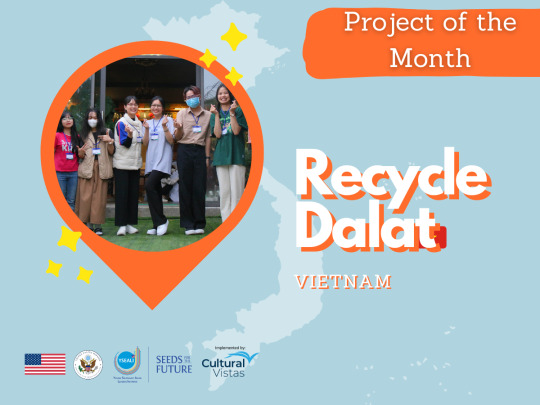
About the Project
Established in January 2022, Recycle Dalat is a non-profit project. We aim to protect the environment with a commitment to create and maintain a community with a green lifestyle, who love Da Lat centered on 3 areas: Cognition · Recycle · Afforestation.
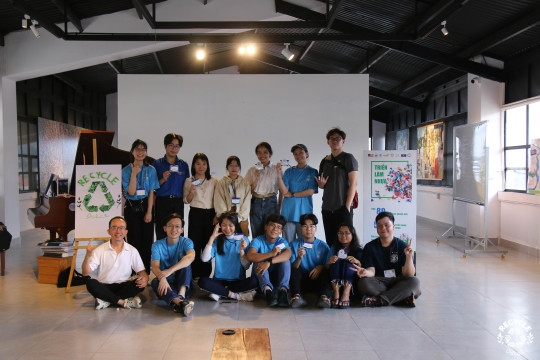
Why do you care about this specific topic/issue?
Vietnam is one of the largest plastic polluters globally, discharging ~1.8 million tons of plastic waste into the environment annually. Vietnam also loses ~2,430 hectares of forest annually. These 2 problems both contribute to all 3 of the Triple Planetary Crisis - climate change, biodiversity loss, and pollution - making them critical issues to tackle should we wish to protect the environment.
Why did you decide to start this project?
As a young person born and raised in Da Lat, I (Nghi) witnessed Da Lat's economic development and the problems that came with said development. One problem was waste, and its effect on the quality of life of my fellow Da Lat citizens.
Instead of waiting for someone to do something for Da Lat, a mountainous area, I decided take matters into my own hands. Recycle Dalat was thus born, to contribute to a cleaner, greener, and prettier Da Lat.
Lee, Hnin, Aung and I are alumni for the YSEALI Fall 2022 Academic Fellowship Program to Hawaii. Through the program, we discovered that we work well together and have similar interests in tackling environmental problems. Together with the help of my mentor, Hanh, we further developed the project. We took advantage of my existing connections and network in Da Lat, Vietnam; Yang’s critical and creative thinking skills, having designed an environmental card game in Singapore; Aung and Hnin’s passion and drive, as well as their communication skills and dedication to protect the environment. Hanh, my mentor, is a well-connected individual in Vietnam who also helped significantly with the project. He is also very experienced as he has been working on the afforestation program. Together, the team represents talented and ambitious youths from around Southeast Asia that are ready to drive impact through a project that is for Southeast Asia, by Southeast Asians.

What are your goals for this project?
Recycle Dalat attempts to protect the environment and develop a community with a green lifestyle. At the end of the project, we hope to:
Increase plastics collection and recycling rates in Da Lat, Vietnam, with aims to inspire more than 100 youths to adopt the habit of recycling plastics and to treat more than 2,000 kg of plastic waste.
Plant more than 3,500 trees over 3 hectares of land in Vietnam through our partnership with the JOY Foundation, and inspire 1000 youths to participate in the tree planting.
Develop Vietnamese youths into future leaders and help them build connections with their peers from Myanmar and Singapore through our 5-week long online workshop with 100 Southeast Asian youths, 15 social media articles outreach, 1 plastic exhibition and 50 sets of prototype environmental card games. In total, we wish to reach 20,000 youths.

How will YSEALI Seeds help you achieve your goals?
YSEALI Seeds provided us with the financial resources required to scale the project. Most of our activities would not be able to be conducted at scale without the YSEALI Seeds grant. We also found that working at a sufficiently large scale makes it easier for us to find partners.
YSEALI Seeds also help us more easily build connections with various organizations, as Recycle Dalat can leverage the YSEALI Seeds branding to more easily convince others to partner with us.
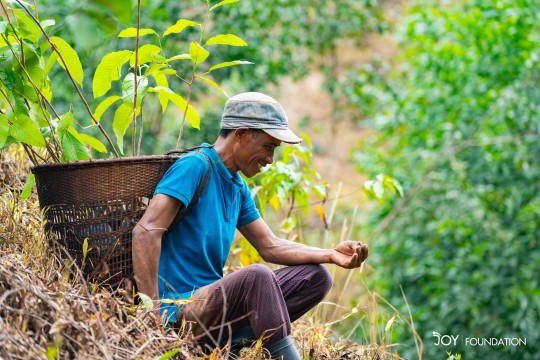
What have you accomplished and implemented so far?
The Recycle Dalat held a total of 3 exhibitions on 20, 21 May, 22 May at the SOS Village, Pedagogical College of Dalat and Yersin University respectively. In total, 660 participants joined our exhibition over the three days. We also collected a total of 738 kg of recyclable waste. 110 kg of low-valuable plastic waste were sent to Plastic People in Ho Chi Minh City, and the remaining waste that can't be recycled in Da Lat were sent to the local recycling facility. We are in the process of planning our online workshop. We have received 269 applications for it, and have confirmed 2 of the 3 guest speakers. We are planning plant 4,000 trees in June, with the saplings growing well in a nursery.
What are the most significant lessons learned you've experienced so far?
To always have back-up plans. From the start of our project, we constantly experienced partners who canceled on us last minute despite numerous confirmations on their end. This means that as much as possible, the team has learned to complete tasks in-house and organize our own events instead of relying on other organizations. Adopting a better safe-than-sorry mindset is draining on our resources, but also provides a peace of mind that the project can still run smoothly in the event of a worst case scenario.
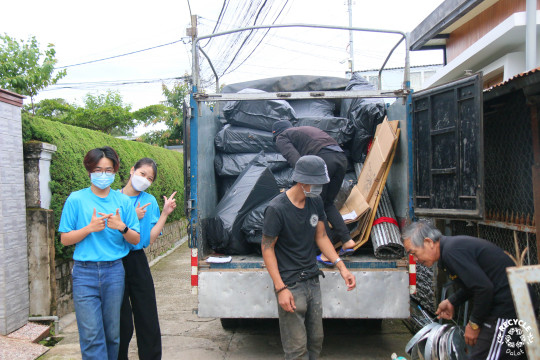
What are the success stories you can share with others who would like to do the same type of activity and/or project like yours?
Our 2 biggest success stories are our in-person plastic exhibitions and the amount of recyclable waste we have collected thus far.
Our in-person plastic event was a great success. Despite our event being held at poor time slots (such as weekends, holidays or during examination periods), many students still came to support our event. In total, we received 660 students over 3 exhibitions at 3 different schools. The students were also very enthusiastic about our workshop and brought 147 kg of recyclable waste for us. This was around two-thirds of all the recyclable waste we collected in May. We also received a lot of positive feedback from the students and were pleased that they enjoyed the event. We hope that this positive feeling towards recycling can stay with them forever and inspire them to continue doing so in their everyday lives.
We have also collected ⅓ of our goal for recyclable waste, having collected 738 of 2000 kg of recyclable waste. This was done in partnership with various schools, organizations and the members of the community. We also reached the milestone sooner than we expected, which was around July-August. When walking around Da Lat and looking at the clean streets, we feel proud knowing that our home is clean in part due to the project.
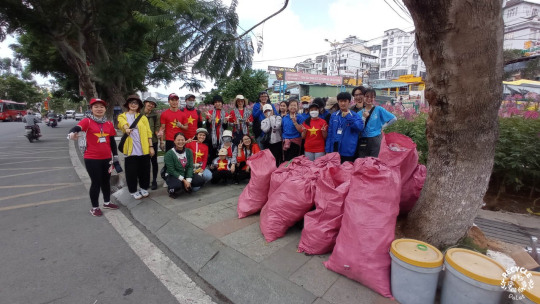
2 notes
·
View notes
Text
The Role of Youth in Driving Social Change
The Role of Youth in Driving Social Change
https://mattdixongreenvillesc.net/the-role-of-youth-in-driving-social-change/
In today’s rapidly changing world, the involvement of youth in driving social change has become increasingly significant. Young people possess unique perspectives, energy, and passion that can catalyze positive transformations in their communities and beyond. Here, we explore the essential role of youth in driving social change and the strategies they employ to make a meaningful impact.
1. Catalysts for Innovation and Creativity
Youth are natural innovators and creative thinkers, often unbounded by conventional norms and constraints. Their willingness to question the status quo and their newfound perspectives make them important social innovation catalysts. Whether through technology, art, activism, or entrepreneurship, young people bring novel ideas and solutions to address pressing social issues, driving change in diverse sectors such as education, environment, and healthcare.
2. Agents of Advocacy and Activism
Empowered by social media and digital connectivity, youth are increasingly vocal and active in advocating for causes they believe in. From climate action to human rights, young activists worldwide are leading grassroots movements and campaigns to raise awareness, mobilize communities, and hold decision-makers accountable. Through protests, petitions, and online activism, youth amplify marginalized voices, challenge injustices, and push for systemic change on local, national, and global scales.
3. Builders of Empowerment and Resilience
Youth engagement in community development initiatives fosters empowerment and resilience among individuals and groups. By involving young people in decision-making processes, skill-building activities, and leadership roles, communities harness their potential as change agents and future leaders. Youth-led initiatives promote inclusivity, diversity, and social cohesion, creating spaces for dialogue, collaboration, and collective action to address shared challenges effectively.
4. Drivers of Sustainable Development
Youth have a stake in advancing sustainable development strategies that protect the environment and raise living standards for both current and future generations because they are the planet’s heirs. Through education, advocacy, and grassroots projects, young environmentalists advocate for climate action, biodiversity conservation, and sustainable resource management. By promoting sustainable lifestyles and advocating for policy changes, youth contribute to building resilient and environmentally sustainable societies.
5. Partnerships and Collaboration
Recognizing the importance of intergenerational collaboration, youth actively seek partnerships with diverse stakeholders, including governments, civil society organizations, businesses, and academia. By leveraging their networks and expertise, young people amplify their impact, access resources, and influence decision-making processes. Collaborative initiatives such as youth councils, mentorship programs, and cross-sectoral partnerships facilitate knowledge exchange, capacity building, and collective action for social change.
The role of youth in driving social change is indispensable for building inclusive, equitable, and sustainable societies. By harnessing their creativity, advocacy, empowerment, and collaboration, young people contribute to addressing complex challenges and shaping a better future for all. In addition to being morally required, investing in youth empowerment and participation is a calculated risk that will pay off in the long run by strengthening global societies and producing future leaders.
The post The Role of Youth in Driving Social Change first appeared on Matt Dixon Greenville SC | Philanthropy & Community Involvement.
via Matt Dixon Greenville SC | Philanthropy & Community Involvement https://mattdixongreenvillesc.net
0 notes
Link
0 notes
Text
Wildlife Warriors: Youth Leading the Charge in Animal Advocacy | UNESCO Body and Mind Wellness

In an era marked by environmental challenges and the urgent need for conservation, youth around the world are emerging as formidable wildlife warriors, passionately advocating for the protection and well-being of Earth's diverse species. Armed with empathy, knowledge, and a fervent desire for positive change, these young individuals are leading the charge in animal advocacy, embodying a spirit of activism that is reshaping the future of wildlife conservation.
Education forms the bedrock of youth-led animal advocacy. With unprecedented access to information, today's young individuals are arming themselves with knowledge about endangered species, habitat loss, and the impact of human activities on wildlife. They are not merely spectators; they are informed advocates who understand the intricate connections between ecosystems and the delicate balance that sustains life on our planet.
The power of social media becomes a potent tool in the hands of wildlife warriors. Platforms like Instagram, Twitter, and TikTok allow youth to amplify their voices, share compelling stories, and raise awareness about the plight of animals. From viral campaigns to captivating visuals, these digital natives leverage the reach of social media to galvanize support, inspire action, and spark conversations that transcend geographic boundaries.
Youth-led conservation projects are making a tangible impact on the ground. From organizing tree planting initiatives to participating in beach clean-ups, young animal advocates are actively engaged in hands-on projects that contribute to the preservation of natural habitats. Through these initiatives, they not only address immediate environmental concerns but also foster a sense of responsibility and stewardship for the planet.
Advocacy extends beyond screens and projects, as youth actively lobby for policy changes and participate in conservation efforts at local, national, and international levels. Whether it's attending conferences, collaborating with environmental organizations, or petitioning governments, these wildlife warriors are determined to see tangible changes in legislation and enforcement that safeguard the welfare of animals and their habitats.
The commitment to ethical and sustainable practices is a hallmark of youth-led animal advocacy. From promoting responsible tourism to advocating for cruelty-free products, young individuals are reshaping consumer behaviors and encouraging eco-friendly choices. Through their influence as consumers, they are driving industries towards practices that prioritize the well-being of animals and the planet.
Collaboration and networking among youth advocates amplify their impact. By forming alliances, sharing resources, and collaborating on initiatives, these wildlife warriors create a united front against the threats faced by animals. The sense of community and shared purpose among youth advocates enhances their effectiveness and ensures that their collective voice is heard on a global scale.
In conclusion, wildlife warriors represent a generation of empowered and compassionate youth who are not bystanders but active participants in the fight for animal advocacy. Through education, social media, hands-on projects, policy advocacy, ethical choices, and collaboration, these young individuals are leading the charge to protect the rich biodiversity of our planet. As they continue to shape the narrative of wildlife conservation, their passion and determination inspire hope for a future where humans and animals coexist harmoniously on a thriving and sustainable planet.
#better health#unesco#sustainability#lifestyle#unesco body mind wellness club#unesco bmw#education#mental health#non profit#animals#youth
0 notes
Text
Young people’s leadership, drive for justice, the best signals of hope that biodiversity loss can be halted
Young people’s leadership, drive for justice, the best signals of hope that biodiversity loss can be halted
“Beyond biodiversity, beyond climate, there is a central question in the world today and that is justice. We live in a system in which both the economic rules and the financial architecture are morally bankrupt,” the UN chief told a side event organized by the Global Youth Biodiversity Network and other youth groups, ahead of the official opening of COP15, the latest edition of the UN…

View On WordPress
0 notes
Photo
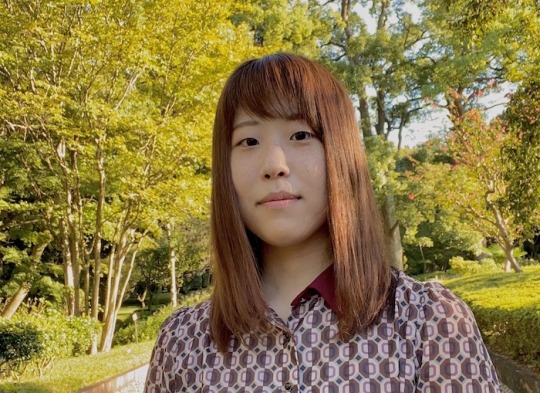
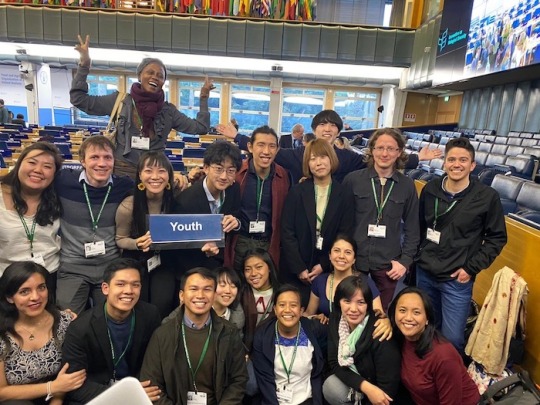
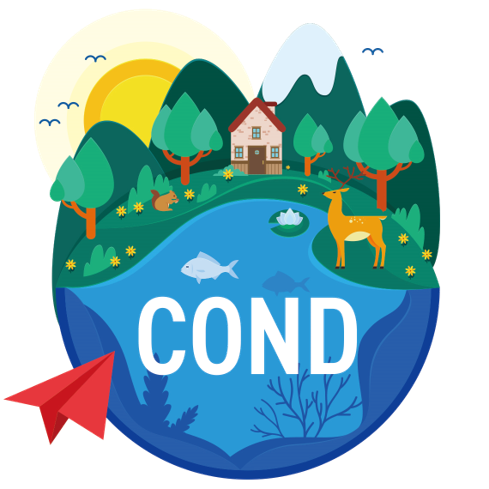


【若者が突き動かす「生物多様性サミット2022」 代表の大学院生に狙いを聞く】 - サステナブル・ブランド ジャパン | Sustainable Brands Japan : https://www.sustainablebrands.jp/article/sbj_interview/detail/1207201_2775.html : https://archive.ph/jdhAe
2022.02.18
{{ 図版 1 }}
「次の10年」に向け、気候変動と表裏一体をなす危機として、生物多様性が重要視される。2030年を達成年とする「ポスト2020生物多様性枠組」はコロナ禍で採択が遅れているが、そんな今だからこそこの問題に対する人々の関心を高め、失われた生物多様性を回復させるための行動につなげようと、チャレンジを続ける若者たちがいる。生物多様性について街づくりやESG投資といった観点から理解を深め、明日から行動できるよう啓発する若者主体のオンラインイベント「生物多様性サミット2022」が19日に開かれるのを前に、主催する一般社団法人「Change Our Next Decade(COND)」代表の千葉大学大学院生、矢動丸琴子さんに話を聞いた。(廣末智子)
■《COP14など計8回、生物多様性の国際会議に参加して感じたこと》
「生物多様性が豊かだということは、権利の一つだと思います。その権利を何かしらの形で脅かしている人と、脅かされている人がいる。多くの場合、その脅かされている人は南半球の人だったり、先住民の人だったり、弱い立場の人たちであるのを強く感じています」
そう、言葉を選ぶように話す矢動丸さん。2020年11月にエジプト・シャルムエルシェイクであったCOP14をはじめ、通常2年に1度開かれる締約国会議の合間に行われる準備会合や作業部会にこれまでリアルで5回、オンラインで3回、日本のユースとして参加した。そうした場で目に焼き付いているのが、先住民や女性、そしてユースが自らの権利を強く主張する姿だという。
それを象徴する文言は、現時点までに国連が発表している「ポスト2020生物多様性枠組」の1次ドラフト(草案)にも示されている。劣化した生態系の20%を再生・復元し、外来生物の侵入率を半減させるなど21項目からなるターゲットの中に「生物多様性に関連する意思決定への衡平な参加、先住民族、女性、若者の権利確保」の文言が盛り込まれたのだ。
「公式文書に書きこまれたことで、国際社会はもう無視できない。プロモーション的に会議に呼んでおけばいいというのは通用しません。椅子があるからいいでしょ、というのは違う」
話に「椅子」が出てくるのは、矢動丸さんが象徴的だと感じるエピソードに基づく。生物多様性条約は気候変動枠組条約とともに1992年に誕生し、両者は「双子の条約」とされるが、2010年のCOP10を知るメンバーによると、生物多様性条約の国際会議には、早い段階から座席にある特徴があったのだという。
「オブザーバー席に、女性グループや教育機関、NGOにユースと、それぞれの札が付いていたそうなんです。座席に札がある=正式に発言ができる、ということ。そういう意味で包括的であり、みんなで一緒に作ろうね、という仕組みを勝ち取ってきたのが生物多様性条約だと思います。ポスト2020の草案ではそれが一歩進んだ形です」
初めて参加した2018年7月のカナダ・モントリオールでの「SBSTTA(通称サブスタ、Subsidiary Body on Scientific, Technical and Technological Advice=生物多様性条約科学技術助言補助機関会合)-22」では、さまざまな議題がある中、「若者として、この議題ではこれを勝ち取っていきたい」という世界のユースたちの熱量に驚かされ、ブラジルとドイツのメンバーが、2012年にインドのCOP11で設立されたGlobal Youth Biodiversity Network(GYBN、通称ギブン)の提案者だったことにも刺激を受けた。
国際社会に対して若者が声を上げたという面ではグレタ・トゥーンベリさんを先頭に世界に広がった気候危機を巡る運動が頭に浮かぶが、生物多様性の危機についても早い段階で若者たちが動いていたことを矢動丸さんが肌で感じたことが伝わる。
{{ 図版 2 }}
■《日本の「行動を起こしたいユース」をサポート、団体立ち上げ政策提言》
矢動丸さんは現在、千葉大学の博士後期課程の学生で、環境健康学や人間植物関係学、環境教育学を専門とする。生物多様性条約の国際舞台に立つことになったのは、博士課程に進むと同時にIUCN-J(国際自然保護連合日本委員会)でのアルバイトを始めたのがきっかけで、最初は会議の進行プロセスに追いついていくのも大変だったのが、世界の若者の議論を目の当たりにするうちに「自分も含め、日本の若者たちはこんなにのほほんとしていていいのか」と強く思うようになったという。
行動に移したのは早かった。2019年8月には任意団体を立ち上げ、COP15に向け、日本全国の「行動を起こしたいユース」たちにこの10年の振り返りと次の 10年に向けた仕組みを検討してもらう「生物多様性ユースアンバサダー事業」をIUCN-Jとの協働で開始。矢動丸さんの役割はユースたちのサポートで、「ドクター(博士号)はまた取れるけど、2020年は一度しかない」という思いから大学院を休学して活動に専念した。
団体は当初、1年で解散する予定だったが、「体制を整えてもっと頑張ろう」と昨年8月に一般社団法人に。コロナ禍で活動が制限される中、法人化前から力を入れてきたことの一つに政策提言がある。CONDとして当時の小泉進次郎環境大臣と計4回意見交換を行ったり、直近では昨年12月に生物多様性国家戦略小委員会にも出席した。
ポスト2020の目標設定を巡る流れの中で、世界のユースは、Intergenerational Equity(世代間衡平=次世代のために健全な地球を確保する上で、すべての世代で共通だが差異ある責任を共有すること)とHuman Rights & the Rights of Nature(人権と自然の権利)、Transformative Education(変革的教育)の3つを優先事項とすることに言及。日本のユースとしても、上記の政策提言などの場で、「政策策定時には世代間衡平の視点を必ず組み込むこと」に加え、陸域に比べて調査が不十分であるとの指摘もされる海洋の保全、そして「自然を守るに当たっては、海も山も川も全部つながっていることを意識し、連結性を確保した上で取り組むべきだ」ということを主張し続けている。
もっとも活動を続ける中では、苛立ちを感じる場面も少なからずあるようで、「国際的にユースの席が用意されているといっても、日本ではまだまだだと感じることも多いです。最近は若者の声を聞くのが流行しているような節もありますが、まだ、パネリストにユースを入れておけばいいといった感覚でディスカッションに呼ばれることもあり、若者の代表としてグレタさんのように怒ってくれれば、何か疑問を呈してくれればいいから、と言われたこともあります。マスコットキャラのような扱いを受けるのはどうかと思いますね」と本音も語る。それでももちろん屈することなく、ユースとして、CONDとして「現在の発信方法のみで十分なのか、どうなのか」と自問を続け、今がある。
■《日本は経済発展を優先しているのではないか》
{{ 図版 3 : COND }}
そんな矢動丸さんが「気候変動対策と生物多様性との両立」について訴える時、よく例に出すのが「ウェディングケーキモデル」として知られるSDGsの構造図だ。その土台は「生物圏」であり、目標14「海の豊かさを守ろう」と目標 15「陸の豊かさも守ろう」が、目標6「安全な水とトイレを」目標13「気候変動に具体的な対策を」とともに並ぶ。
「人間活動や社会経済活動は、環境を基盤にして成り立っている。環境が疎かになると、回り回って社会や経済もうまく回らなくなるということです。生物多様性は独立した問題としては語れないことをよく表していると思います」
そう考え、日本のSDGsの達成状況を振り返った時、日本は、SDGsの進捗状況に関する国際レポートの {{ 結果 : SDGs達成度ランキング、日本は18位:「行動の10年」世界は具体的な行動と投資の加速を 2021.06.16 : https://www.sustainablebrands.jp/article/story/detail/1203005_1534.html : https://archive.ph/MXnyj }} からも、特に目標14と15に課題が大きいと指摘されていることに思い当たるという。
「世界的にみると、意識の高い国がリードして意見をまとめていますが、翻って日本はどうなのか。経済発展や開発と、生物多様性や自然環境の保全をどう両立していくかという時に、日本は経済発展を優先しているのではないでしょうか。生物多様性は無くなってからでは遅いのに。経団連には『自然保護協議会』もあり、変わろうとしている企業は多いですが、政治家にも経済を回す上でもっと自然環境に配慮してほしいと思います」
最近では再生可能エネルギーの一つである「バイオマス燃料」として使用するために森林破壊が進むなど、世界的にも気候変動対策との矛盾が大きな問題になっており、日本でもメガソーラーの設置に伴う森林伐採が景観の悪化や土砂災害などを招いているという批判もある。
「脱炭素社会のために今はそうするのがいいと思ってのことでしょうが、10年、20年後に、あの時、森を伐ってしまったためにあの植物が生えなくなった、あの動物が、あの虫がいなくなった、としても、もうそれは戻ってこない。私たちや、もっと下の世代はその森の恩恵を受けられない。それは、世代間の権利が平等じゃないということです」
■《日本人の生物多様性に対する認知度、危機感の低さを危惧》
そんな強い思いに反して、例えば令和元年度の内閣府の調査で生物多様性について「聞いたこともなかった」とする割合が47.2%であったり、2021年の民間調査で、日本人が危機的だと感じる環境問題の1位は気候変動の44.6%であるのに対し、生物多様性はわずか1.9%に過ぎないなど、生物多様性についての認知度は低く、危機感が浸透していない実態を危惧。そのハードルの一つには「『生物多様性』という言葉が難しい、専門家が扱うもので自分には関係ないと考えている人が多いのではないか」と推察する。
矢動丸さん自身、生物多様性について深く理解したのは2018年に国際会議の舞台に立つようになってからのことだった。その経験からも今、力を入れるのが、人々がどのような状況にあるために生物多様性保全について行動を起こしていないのか、起こし方が分からないのか、「働きかけたい相手」の立場でアプローチを行うことに重きを置いた啓発だ。
その一環で、2月19日には一次産業や街づくり、ESG投資やグリーンインフラ、ナッジ(行動変容)など、「生物多様性を軸としつつ、それに関わる、ほかの入り口をたくさん用意」したイベント「 {{ 生物多様性サミット2022 : https://prtimes.jp/main/html/rd/p/000000001.000093193.html : https://archive.ph/hN008 }} 」をオンラインで開催する。講師には、環境省のグリーンファイナンス検討会や金融庁のサステナブルファイナンス有識者会議などの座長を歴任する水口剛・高崎経済大学学長や、農林水産省の生物多様性戦略検討委員会と環境省の生物多様性民間参画ガイドライン改定検討会の委員も務める、りそなアセットマネジメント執行役員の松原稔氏ら錚々たる顔ぶれが並ぶ。
{{ 図版 4 ~ 5 : 生物多様性サミット }}
「自然の魅力を伝えるだけで生物多様性の主流化が実現するのであれば、IPBES(生物多様性及び生態系サービスに関する政府間科学政策プラットフォーム)でTransformative Change(革新的な転換)の必要性が言及されることもなかったと思います。さまざまな社会課題が複雑に絡み合っている現代において、自然を守ることは、人々の権利や社会基盤を守ることです。生物多様性と自分との関わりが分からないと思っている人に、あなたの生活は何で成り立っているの?それは生物多様性の���ころだよ、と。そのことをちゃんと理解してくれる人が増えてくれればと思います」
コロナ禍で中国・昆明でのCOP15の延期が続き(一部は昨年10月に開催)ポスト2020枠組の採択が遅れている今、2030年までの時間は刻々と減っている。それだけに、「これまでとは違う方法でのより一層の行動が求められます。起こすアクションの大きさは関係なく、継続することが何よりも重要」と強調。「ユースの最大の強みは失敗を恐れず果敢に挑戦できるところ。他のNGOや行政などさまざまなステークホルダーと協働し、対等な関係で行動を加速させていきたい」と日々決意を新たにしている。
◆廣末智子(ひろすえ・ともこ)
地方紙の記者として21年間、地域の生活に根差した取材活動を行う。2011年に退職し、フリーに。サステナビリティを通して、さまざまな現場の当事者の思いを発信中。
#naturejp#envirojp#naturediversityjp#naturediversity#climatecrisisjp#securityjp#socialjp#edujp#economyjp#politicsjp#crisisjp#newsjp
0 notes
Text
Teaching children the value of biodiversity to re-training adults in sustainable professions.
A growing number of young people agree that transforming our education systems holds the key to transforming our future, from teaching children the value of biodiversity to re-training adults in sustainable professions. But despite support from the youth community, the potential of transformative education remains largely unrecognised, writes Swetha Stotra Bhashyam of the Global Youth Biodiversity Network (GYBN), an IUCN Global Youth Summit partner.
#Global Youth Biodiversity Network (GYBN)#Biologically diverse#Biodiversity#Courses#Biological Diversity#Transforming Our Education System
0 notes
Text
Radical Rituals
forty-five degrees is an open collective of architects and designers dedicated to the research and critical making of collective space. They take different forms when engaging in collaborations with other experts, adapting to the project’s scope. In their practice, space-making is about resources, not only material or financial but the intangible resources of human and non-human knowledge.
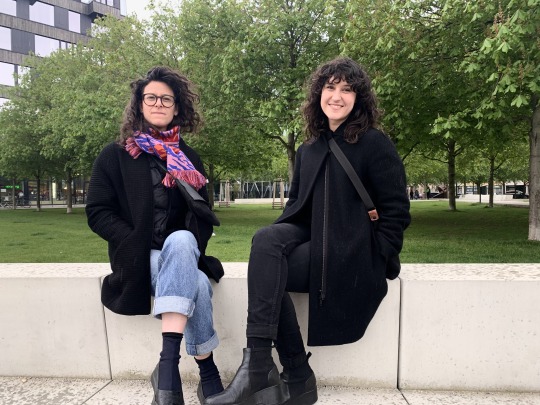
Talking in the park in front of Tageszeitung in Berlin-Mitte with Alkistis Thomidou and Berta Gutierrez. | Photo © Boštjan Bugarič
Their work aims at investigating the built environment through research, design and artistic experimentation, across multiple scales and in its social, economical and structural entanglements.They are collecting protocols and collective approaches, exploring alternative living and city making models and new paradigms of urban development to engage with communities and local agents. They strive to create inclusive and accessible spaces through careful use of scale, material and design language with a commitment to rethinking education through academia and practice placing design at the intersection of arts and sciences. Berta Gutierrez and Alkistis Thomidou were talking to Boštjan Bugarič.
***
For this interview we meet in a new park next to Hejduk’s Tower; why did we meet here?
BG: I really appreciate Hejduk's theoretical work and I find it very relevant nowadays since I believe it can give us many leads on how architecture should be taught during the contemporary crisis.

In 2010 the architecture community gathered to protect the Kreuzberg Tower as new owners began altering the facade. | Photo © Boštjan Bugarič
Around this park are also other important buildings?
AT: On the other side we find a first cooperatively built project for offices, FRIZZ, and on the other there is also the new TAZ building.
This park is divided with paths (lines), how can we create these lines?
AT: This area had a very strange atmosphere although it is quite central. I am actually the first time in the park after its renovation. These lines cutting through the space shall be a result of shortcuts where people cross the former park, literally, the footprint.

“Radical Rituals” is an itinerary survey along the 45ºN parallel, on the inventiveness of everyday life, new hybrid vernacular practices and rituals that stimulate and nurture the commons across Europe. | Photo © forty-five degrees
What about your line, the forty-five degree? What is a project about?
AT: The name came along with the idea of a research of the 45ºN parallel as many people in our team come from the south of Europe but studied or work and live in the north part of Europe. This line has influenced our way of thinking and although it is a fictional line it burdens Europe and represents a border that people try to cross every day from South to North. We wanted to investigate what is happening along this line that crosses France, Italy, Croatia, Serbia, Romania all the way to the Black Sea. Although it cuts the middle of Europe, cities around it are considered ‘peripheral’. We are researching how the European identity is reflected along this line.

Polarisation between north and south, heterogeneous economic models, diversity of cultural and historic backgrounds. | Photo EW Elsevier Weekblad, Issue 22, 2020
What have you discovered so far?
BG: We are currently preparing our first field trip, and we will be in Romania and Serbia by September. Right now this is a very fascinating part of the project as it is like a zoom into the ground. If you go very far away, you see the meridians and parallels as the way of shaping the world, but when you start to get closer, you see countries, borders, cities, landscapes and people. We would like to zoom in as much as possible, so we can really understand local situated practices that are happening in very specific physical environments.
AT: The project “Radical Rituals” is a survey on very local spatial practices or initiatives that addresses climate challenges, space justice and biodiversity. We want to be surprised by what we learn along the way, what kind of collectivity is created and how local identities can influence space production.

A British writer Shumon Basar references the metallic flowers of Hejduk on the facade as,"grips for angels to hold onto when they climb the sides of the tower” inspired by “Wings of Desire"by Wim Wenders. | Photo © Boštjan Bugarič
BG: In this sense it is great that we are in front of Hejduk’s building because he proposes the way in which design comes as a result of small narratives or characters entangled with each other, working with crafts or local materials and contexts. For us the exercise is similar, but instead of working with fiction we work with reality as nowadays reality is complex enough. We don’t have all the answers to these challenging topics, but we believe that this exercise will give us a sort of light.
AT: Through this research we want to see what stories point to possible futures and possible present-s as people develop tools and knowledge that is embedded in the context of the local space. We worked on this concept at the Architecture Triennial in Oslo, where we created a digital Atlas that connects OAT’s archive and discourse with the transformations that take place on the city’s ground through local initiatives. We encountered initiatives that manage to achieve systemic changes and give multiple answers to the big challenges we are facing. In a way, proving that the environment is a primal source of our knowledge.

Oslo In Action(s) is a research project uncovering city-makers who stimulate and nurture the commons beyond the boundaries of professional practice.
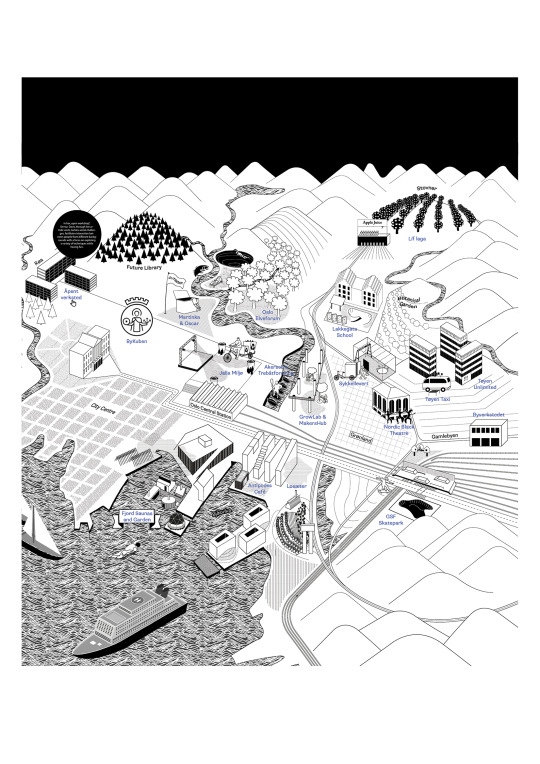
The Digital Atlas was commissioned by the Oslo Architecture Triennial for their 20th jubilee “Conversations about the city". | Photo © forty-five degrees
Your practice was as well put on the list of the Future Architecture Platform? How do you see yourself in the FAP?
AT: It was an important experience to have this opportunity of working with people and institutions. We met extremely generous and inspiring people in Ljubljana and then in Oslo. Then, we got the digital research fellowship at Architectuul which enables us to meet and connect with other projects and not just sit in our office and work on the research but expand our network and bring different perspectives together. We are very grateful that the Future Architecture Platform gave space for this project.
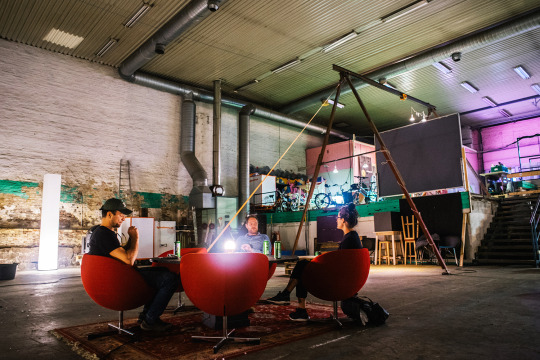

Initiatives in Oslo (up) and Urtegata Sykkellevert space for multimedia production and Tøyen Taxi. | Photo © forty-five degrees
Just finished curating a panel on Kvadrato, how did you choose panels and why you wanted to present them?
AT: The panel was called ‘Communication for Commonalities’, where we invited diverse initiatives that work collectively and with several communities. Their work spans from creating digital platforms that communicate collective intelligence on a global scale, to very local projects that engage directly with a variety of actors on the ground.


With Akerselva Trebåtforening, we paddled on a 100-year-old wooden boat on an underground river running into the fjord (up); Losæter is the city farm of Oslo. | Photo © forty-five degrees
BG: It was a great example for us to address our questions and concerns and discuss them in the context of communication of architecture. As we know, communication in architecture is about media and its symbolic representation. Nevertheless, for us communication is related with the ground, physical context, methodologies and the communication channels that people use to promulgate the project with peers or bigger networks.

The Fjord floating saunas - Oslo Badstuforening. | Photo © forty-five degrees

The legendary GSF Skatepark. | Photo © forty-five degrees

The Oslo fjordhage, a floating classroom dome. | Photo © forty-five degrees
How you integrate the theoretical methods in the learning process?
BG: In my personal research I try to answer the question of how do we promote other ways of learning coming from non-disciplinary practices since academia became such a rigid space with a very outdated curriculum. With non-disciplinary practices beyond academia we can really find many inputs on this crossing.

Berta Gutierrez and Alkistis Thomidou | Photo © Boštjan Bugarič
AT: We are currently collaborating with two other international practices on an Erasmus+ Youth in Action project on how to learn together. During the next two years we will develop formats of different ways of learning and engaging youth to physical interaction with various spaces in the city, public, private or common areas. We see the engagement of young adults in space-making processes as a project of emancipation and investment in the future.
2 notes
·
View notes
Text
Սիրելի հետևորդներ, տարածեք ինչքան կարող եք, խիստ կարևոր։
Հայերենը ներքևում
🔴 Ecocide Alert in Nagorno–Kharabakh region amidst war between Armenia & Azerbaijan
Dear Partner,
As you may be aware, on September 27th, 2020, full–blown war exploded between Armenia & Azerbaijan over Naghorno-Karabakh (Artsakh) with four ceasefire regimes negotiated under the umbrella of Minsk OSCE Group, violated during October, 2020.
During this large-scale war, the most intensive since the 1994 ceasefire agreement in the Southern Caucasus region, a number of war crimes were mounted & documented, among them beheadings of Armenian soldiers, killing of civilians in a city square wrapped in Armenian flags, deliberate attacks on
civilian infrastructures - residential buildings, churches, food markets, schools and maternity hospitals.
On October 30, 2020, the environmental community of Armenia, including local, regional & international environmental organizations, conservation pioneers, scientists and non-governmental organizations, was shocked to witness another disastrous war crime against natural ecosystems & crucial livelihoods of Artsakh.
As per credible reports & collected data, comprised by Human’s Right Defender of Armenia, Azerbaijani military forces have used white phosphorus munitions containing elements of chemical weapons in the primary forests of Artsakh, which is a gross violation of International Humanitarian Law, principles of Customary Law, Geneva Convention, Chemical Weapons Convention, Convention on the Prohibition of Military or Any Other Hostile Use of Environmental Modification Technique, as well as the provisions of the relevant UN conventions and documents. As video evidence shows, these weapons are being used in an
attempt to burn down forests where-civilians are taking shelter from Azerbaijan’s attacks.
The ongoing large-scale war seriously threatens the biodiversity of the region, which has been recognized
as one of the world's biodiversity hotspots. This region is well-known for its high rate of endemism and for being home to more than 6000 plant species, 153 species of mammals, 400 species of birds and other living organisms. Hundreds of plant and animal species found in Artsakh are listed both in the local Red Book and the IUCN Red List of Threatened Species having a protection status at a global level.
Among them are the critically endangered Persian (Caucasian) Leopard, known to migrate through Mrav ridge of Armenia & Artsakh towards the Iranian border, as well as to Azerbaijan and vice versa, which is a rare species with declining numbers protected at a regional & global level.
Furthermore, Armenia & Artsakh are known for their primary forests, which are amongst the most biodiverse forests in the region. Not only do these forests play a major role in preserving favorable environmental conditions for sustainable development, but local people are heavily dependent on these forests for their livelihoods. Traditional forest-related knowledge accumulated over thousands of years is deeply linked with the cultures of indigenous people living in Artsakh.
The usage of white phosphorus munitions by Azerbaijani forces in those forests will not only destroy valuable ecosystems & habitats and put threatened species at the risk of extinction, but will contaminate rivers & underground waters for years, thus turning into a major threat of regional scale for all the people and wildlife living in the region.
We are therefore calling out to the global conservation community for support to help stop the usage of white phosphorus munitions before they cause an environmental disaster and regional ecocide.
The usage of white phosphorus munitions contradicts to all the provisions of all environmental conventions including the Bern Convention, Nagoya protocol to Helsinki & Rotterdam conventions, verified by the Governments of both Armenia & Azerbaijan.
Although 98% of the global population live under the protection of the Chemical Weapons Convention, this
is, as we understand, unfortunately not applicable towards Armenia & ethnic Armenians living in Artsakh.
Ongoing developments continue to threaten any form of life in the region and thus we’re addressing you, as a leading environmental organization in the field, to:
● Write to appropriate contacts & conservation partners in your network to express your concern of the possible environmental destruction in Artsakh and the region
● Raise awareness within your networks/social channels and:
● Condemn the actions of any military force that uses white phosphorus munitions in forests & habitats destroying crucial ecosystems and therefore forbidden under international law.
● Call for responsibility to protect valuable ecosystems, species populations & genetic resources from ecocide in Artsakh.
● Call for moral responsibility in a time of war and exclude war crimes both against humans and nature.
Please kindly inform us, the undersigned, about actions undertaken by your organization advocating for sustainable development & environmental resilience, and further steps aimed at eliminating the risk of the ecocide in Artsakh region, which is a crucial habitat to threatened species & populations not recognizing political borders and/or regional disputes.
Link to video։ https://www.youtube.com/watch?v=qk4WBNmiygo
Yours sincerely,
1. Foundation for the Preservation of Wildlife & Cultural Assets (FPWC),
2. Armenian Society of Biologists NGO,
3. Eco Waste Environmental NGO,
4. Yerevan Aarhus Center,
5. Armenia Tree Project,
6. Sunchild NGO, [email protected]
7. Strategic Development Agency,
8. Solution Hub NGO,
9. Green Age NGO, [email protected]
10. American University of Armenia/Harutyun Alpetyan, Waste Governance Expert,
11. Environmental Public Society,
12. BlEJAN, environmental, social, business support NGO,
13. Araves Bird conservation NGO,
14. Armenian Environmental Front,
15. BEM Youth progressive Action Center
16. Freedom of Information Center of Armenia,
17. Institute of Botany after A.Takhtajyan NAS RA,
18. World Independent Youth Union,
19. Doctor Cinema Youth NGO,
20. Amities Luxembourg - Armenie a.s.b.l,
21. Formation et Sensibilisation de Luxembourg,
22. Regional Development and Research Center NGO,
23. "Econews.am" environmental informative website,
24. Public Awareness and Monitoring Centre' NGO,
25. Dingo Team NGO,
26. SALU (Sensibilité et Attention Luxembourg),
27. Caucasus Wildlife Tours,
28. Armenian Environmental Network,
29. Lab Inclusion (France)
30. Green Armenia Environmental Education NGO,
31. White Squad Environmental NGO,
32. "Armenian Botanical Society" NGO,
33. SwIdeas AB (Sweden),
34. 500 km in Armenia
35. Sunchild Eco - tours, [email protected]
36. BLESK LLC env. assessment org./Armenian Branch,
37. "Dalma-Sona" Foundation,
38. University of Traditional Medicine, Armenia,
39. Armenian Women for Health & Healthy Environment NGO,
40. One Health Coalition,
41. "EcoLur" informational NGO,
42. Clean Goris NGO,
43. Country Water Partnership NGO,
44. Sustainable Water Environment NGO,
45. "Centre for Community Mobilization and Support" NGO,
46. Green Lane NGO,
47. "Consumers' Consulting Center" NGO,
48. My Forest Armenia NGO,
49. "Support of Botanical Garden" Charity Foundation,
50. Armenian Forests Environmental NGO,
ԷԿՈՑԻԴԻ ՎՏԱՆԳ ԱՐՑԱԽՈՒՄ
Հարգելի՛ գործընկեր,
Համոզված ենք, որ տեղյակ եք սեպտեմբերի 27-ից ցայսօր շարունակվող ՝ Լեռնային Ղարաբաղի՝ Արցախի տարածաշրջանում, Հայաստանի և Ադրբեջանի մի��և սանձազերծված պատերազմի մասին, որի, նույնիսկ հումանիտար հրադադարի կնքման մասով, միջազգային հանրության կողմից նախաձեռնած բազմաթիվ ջանքերն ապարդյուն էին:
Հարավային Կովկասում սանձազերծված այս լայնամասշտաբ պատերազմի ընթացքում փաստագրվել են մի շարք պատերազմական հանցագործություններ, որոնց թվում՝ հայ զինվորների գլխատումներ, հայկական դրոշներով փաթաթված քաղ. բնակչության սպանդ, մշակութային – հոգևոր արժեք հանդիսացող եկեղեցու հրթիռակոծում, քաղաքացիական ենթակառուցվածքների միտումնավոր հրետանակոծում, որոնց թվում՝ դպրոցներ, բնակելի շենքեր, քաղաքային շուկա և նույնիսկ ծննդատուն:
Հայաստանի և Արցախի ողջ բնապահպանական հանրույթն ու քաղ.հասարակությունը, որոնց թվում՝ տեղական, տարածաշրջանային կառույցներ և միջազգային բնապահպանական կազմակերպություններ, գիտնականներ և գիտական ինստիտուտներ հերթական անգամ ցնցվեցին հոկտեմբերի 30-ին՝ ականատեսը լինելով Արցախի տարածաշրջանի բնական էկոհամակարգերի և կենսապահպան անտառների նկատմամբ գործած ռազմական հանցագործությունից:
ՀՀ Մարդու Իրավունքների Պաշտպանի կողմից փաստագրված տվյալների համաձայն ադրբեջանական ռազմական ուժերը Արցախի կուսական անտառային էկոհամակարգը թիրախավորել են կիրառելով սպիտակ ֆոսֆորային քիմիական զինամթերք, ինչը միջազգային մարդասիրական իրավունքի, սովորութային իրավունքի նորմերի ու սկզբունքների, Ժնևյան կոնվենցիաների, ինչպես նաև ՄԱԿ-ի համապատասխան կոնվենցիաներով ու փաստաթղթերով նախատեսված դրույթների կոպտագույն խախտում է:
Ցայսօր շարունակվող լայնամասշտաբ պատերազմը տարածաշրջանի բնական էկոհամակարգերի ու կենսաբազմազանության լուրջ սպառնալիքներից է: Հիշեցնենք, որ մեր տարածաշրջանը միջազգային առաջատար բնապահպանական կառույցների կողմից ճանաչվել է որպես աշխարհի կենսաբազմազանության թեժակետերից մեկը, ասել է թե՝ պիտի պահպանվի համաշխարհային մակարդակով:
Մեր տարածքը հայտնի է էնդեմիզմի բարձր մակարդակով՝ բնական կենսամիջավայր ապահովելով ավելի քան 6000 բուսատեսակների, 153 տեսակի կաթնասունների և 400 տեսակի թռչունների համար, ինչը համաշխարհային բնական ժառանգություն է: Արցախում հայտնաբերված բույսերի և կենդանիների հարյուրավոր տեսակներ ներառված են ինչպես տեղական Կարմիր գրքում, այնպես էլ համաշխարհային՝ IUCN/ԲՊՄՄ կարմիր ցուցակում՝ որպես անհետացման եզրին գտնվող, համաշխարհային պաշտպանության տակ գտնվող տեսակներ:
Հայաստանն ու Արցախը հայտնի են իրենց կուսական անտառներով, որոնք տարածաշրջանի ամենաբազմազան անտառային էկոհամակարգերից են և կարևոր դեր են խաղում ամբողջ տարածաշրջանի կայուն զարգացման և էկոլոգիական հավասարակշռություն պահպանելու համար, իսկ տեղաբնիկները մեծապես կախված են անտառների բարիքներից: Հազարամյակների ընթացքում ձևավորված ավանդական գիտելիքները նույնպես խորապես կապված են անտառների հետ և ձևավորել են տեղաբնիկների հարուստ մշակույթն ու կենցաղը:
Արգելված զինամթերքի կիրառումը փաստացի վտանգում է մասնավորապես անհետացման եզրին գտնվող գորշ արջի, բեզոարյան այծի, հայկական մուֆլոնի, լուսանի, անգղերի և վերջապես՝ տարածաշրջանի հազվագյուտ, անհետացման եզրին գտնվող Պարսկական (Կովկասյան) ընձառյուծի գոյությունն, որ իր միգրացիան է կատարում նաև Մռավի լեռնաշղթայով՝ անցնելով ՀՀ-ի, Արցախի, Իրանի ու Ադրբեջանի տարածքներով:
Վերացնելով կարևոր ապրելավայրեր ու ոչնչացնելով մի ամբողջ էկոհամակարգ՝ սպիտակ ֆոսֆորական զինամթերքը կուտակվում է հողի և գետերի մեջ, տարիներով աղտոտելով ստորգետնյա ջրերը՝ այդպիսով վերածվելով տարածաշրջանային մասշտաբի սպառնալիքի Հարավային Կովկասում ապրող բոլոր ազգերի համար՝ այդ թվում ադրբեջանցիների:
Սպիտակ ֆոսֆորային զինամթերքի օգտագործումն հակասում է բոլոր բնապահպանական միջազգային կոնվենցիաների դրույթներին՝ Բեռնի կոնվենցիայից, Նագոյայի արձանագրությունից մինչև Հելսինկիի և Ռոտերդամի կոնվենցիաներ, որոնք վավերացված են ինչպես Հայաստանի, այնպես էլ Ադրբեջանի կառավարությունների կողմից: Թեպետ քիմիական զենքի մասին միջազգային կոնվենցիան միտված է պաշտպանելու համաշխարհային բնակչության 98%-ին, այն ակնհայտորեն շրջանցում է Հայաստանում և Արցախում բնակվող էթնիկ հայերին, ինչը մենք անընդունելի ենք համարում:
Քիմիական զենքի այս տեսակը միջազգային հանրույթն օբյեկտիվորեն ճանաչում է որպես ռազմական հանցագործություն:
Բնության պահպանությունը քաղաքական և ռազմական սահմաններ չի՛ ճանաչում, քանի որ բոլորս ապրում ենք միևնույն տարածաշրջանում և օգտվում միևնույն կենսական ռեսուրսներից:
Սպիտակ ֆոսֆորային զինատեսակի կիրառումը կենսաբազմազանությամբ հարուստ այսպիսի տարածաշրջանում անխոս կհանգեցնի բնապահպանական աղետի ու աներկբայորեն կվերածվի տարածաշրջանային էկոցիդի:
Ներկա զարգացումները շարունակում են սպառնալ հարավկովկասյան տարածաշրջանին, և այս աղետը կանխարգելելու նպատակով կոչ ենք անում Ձեզ, որպես ոլորտի առաջատար կազմակերպություն՝
- Ձեր գործընկերներային ցանցին տեղեկացնելու Արցախին և տարածաշրջանին սպառնացող լուրջ վտանգի մասին
- Դատապարտելու ռազմական ուժերի կողմից կենսական անտառների, ապրելավայրերի և էկոհամակարգերի փաստացի ոչնչացումը, ինչն արգելված է միջազգային իրավունքի բոլոր նորմերով
- Պատասխանատվության կոչ անել՝ պաշտպանելու համար արցախյան արժեքավոր էկոհամակարգերը, հազվագյուտ տեսակների պոպուլյացիաներն ու առկա գենետիկ ռեսուրսը սպառնացող էկոցիդից
- Հղում կատարել և պահանջել բարոյական պատասխանատվություն դրսևորել պատերազմի ընթացքում ինչպես մարդկանց, այնպես էլ բնության նկատմամբ
Խնդրում ենք նաև մեզ՝ ներքոստորագրյալներիս, տեղեկացնել Ձեր՝ որպես բնության և կենսաբազմազանության պահպանման համար ջանքեր գործադրող, ունիվերսալ հումանիտար արժեքների ջատագով կազամակերպության կողմից նախաձեռնած գործողությունների ու հետագա քայլերի մասին՝ միտված Արցախյան տարածաշրջանում էկոցիդը կանխելուն, որ բազմաթիվ անհետացման եզրին գտնվող տեսակների ապրելավայր է ու չի ճանաչում ռազմաքաղաքական սահմաններ:
Տեսանյութը՝ https://www.youtube.com/watch?v=qk4WBNmiygo
Հարգանոք՝
1. Վայրի բնության և մշակութային արժեքների պահպանման հիմնադրամ
2. Էկո -աղբ բնապահպանական ՀԿ
3. Երևանի Օրհուսի կենտրոն
4. ՀՀ ԳԱԱ Ա․Թախտաջյանի անվան Բուսաբանության ինստիտուտ
5. Արևորդի ՀԿ
6. Գրին Էյջ ՀԿ
7. Հայաստանի Ամերիկյան համալսարան, Հարություն Ալպետյան, թափոնների կառավարման մասնագետ
8. ԲԼԵՅԱՆ բնապ., սոց. և բիզնեսի աջակցման ՀԿ
9. Հայկական Բնապահպանական Ճակատ
10. ԱրԱվես թռչունների պահպանման միություն
11. Ինֆորմացիայի Ազատության կենտրոն
12. Էկոնյուզ բնապահպանական տեղեկատվական կայք
13. Վայրի կենդանիների դիտարկման գործակալություն
14. Կանաչ Հայաստան բնապահպանական կրթական ՀԿ
15. Համաշխարհային անկախ երիտասարդական միավորում
16. Դոկտոր սինեմա երիտասարդական ՀԿ
17. Լյուքսեմբուրգ-Հայաստան բարեկամության ասոցիացիա
18. Ուսուցում և իրազեկում ՀԿ- Լյուքսեմբուրգ
19. Հայկական բուսաբանական ընկերություն ՀԿ
20. Սպիտակ ջոկատ բնապահպանական ՀԿ
21. Ռազմավարական զարգացման գործակալություն ՀԿ
22. Կենսաբանների հայկական միություն ՀԿ
23. Սոլյուշն Հաբ ՀԿ
24. Էկոլոգիական հասարակական միություն
25. ԲԵՄ երիտասարդների առաջադիմական գործունեության կենտրոն
26. ԷկոԼուր տեղեկատվական ՀԿ
27. Տարածքային զարգացման և հետազոտությունների կենտրոն ՀԿ
28. Հանրային իրազեկման և մոնիտորինգի կենտրոն ՀԿ
29. Դինգո Թիմ ՀԿ
30. SALU/ Sensibilité et Attention, Լյուքսեմբուրգ
31. Հայկական Բնապահպանական Ցանց (ԱՄՆ )
32. Lab Inclusion (Ֆրանսիա)
33. Մեկ Առողջություն կոալիցիա
34. Էյ Թի Փի (Armenia Tree Project)
35. Սվիդեա ընկերություն (Sweden)
36. 500 կմ Հայաստանում նախաձեռնություն
37. Բլեսկ ՍՊ բնապ. գնահատման ընկերություն
38. Դալմա – Սոնա հիմնադրամ
39. Ավանդական բժշկության համալսարան
40. Հայ կանայք հանուն առողջության և առողջ շրջակա միջավայրի
41. Սպիտակ ջոկատ բնապահպանական ՀԿ
42. Հայաստանի անտառներ բնապահպանական հկ
43. Աջակցություն բուսաբանական այգուն բարեգործական հիմնադրամ
44. Ազգային ջրային համագործակցություն ՀԿ
45. Կայուն ջրային միջավայր ՀԿ
46. Մայ Ֆորեսթ Արմենիա ՀԿ
47. Սպառողների խորհրդատվության կենտրոն ՀԿ
48. Համայնքային համախմբման և աջակցության կենտրոն ՀԿ
49. Մաքուր Գորիս ՀԿ
50. Կանաչ արահետ ՀԿ
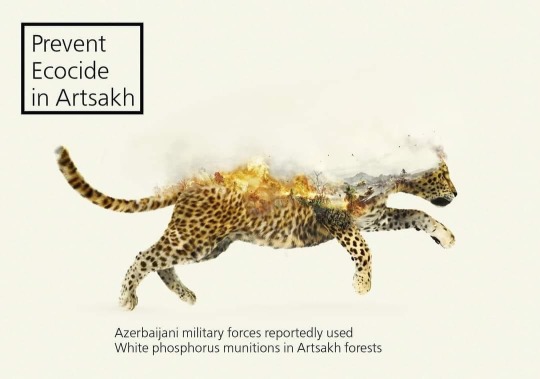
2 notes
·
View notes
Text
YSEALI Seeds: Bluepreneur Asia initiative
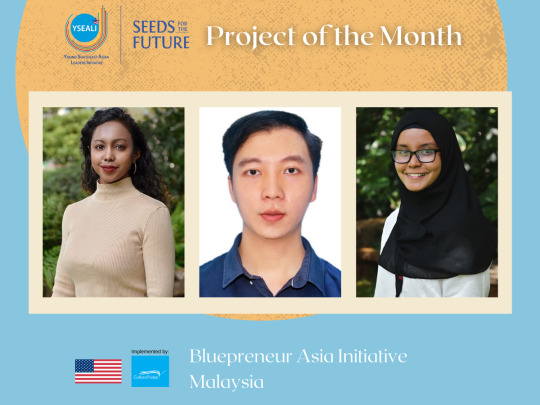
About the Project
Bluepreneur Asia Ventures focuses on implementing social entrepreneurship Bootcamp programs and impact sustainability consulting programs across the Southeast Asia region. The Bluepreneur Bootcamp program on social entrepreneurship is a 4-day long program, that focuses on improving the livelihood of coastal communities, and scaling marine and water solutions across the Asia Pacific region. These idea stage aqua businesses also become connected with a network of entrepreneurship resources, mentorship, peer-to-peer learning that consists of social entrepreneurs, impact investors, and ocean organizations in the Southeast Asia region. Our impact consulting program focuses on providing capacity building training for graduate youths from Indonesia, the Philippines, and Malaysia on consulting organizations, and eco-businesses in optimizing their social sustainability goals.
Why do you care about this specific topic/issue?
We care about scaling impact driven aqua solutions across the Asia region as this region is rich in marine and coastal biodiversity, yet we are experiencing the highest climate disasters with marine degradation, water security and scarcity. We care about what we do mainly because there is little that is being done to address these problems within the Asia region and we believe scaling high impact solutions is important. We also hope to solve the problems of impact scrutinization faced by NGOs, social enterprises, and eco-businesses in scaling their businesses with social and sustainability-based optimizations.
Why did you decide to start this project?
Asia Pacific is home to 60% of the world's water and faces water security and sanitation issues due to pollution, coral bleaching, and ocean acidification. More than 3 billion people rely on the oceans for their livelihood. We figured that integrating ocean solutions with social entrepreneurship is important as we discovered that eco-businesses in the Asia Pacific region lack access to funding, resources, and social impact measurements in growing their eco-businesses within Southeast Asia.
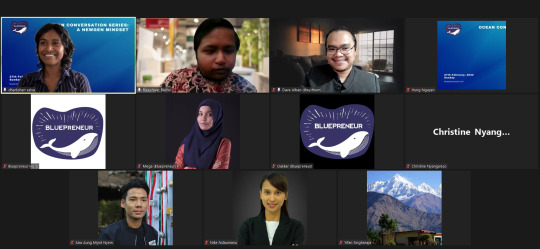
What are your goals for this project?
The main objective of this bootcamp program is to improve the livelihood of coastal communities by ensuring a socially sustainable marine plan that delivers to the local community. More specifically, how it contributes to equity (fair distribution of socio-economic welfare opportunities) and environmental justice (protection from the effects of marine development and pollution).
How will YSEALI Seeds help you achieve your goals?
With the YSEALI Seeds for Future grant, this will help us to implement our Bootcamp and Impact Consulting programs. Similarly, it will ensure that the youth and startups gain the resources to grow their solutions. We are positive that youth will be empowered to execute their marine projects with strong social impact in their local regions across Southeast Asia.
What have you accomplished and implement so far?
We have empowered more than 24 aqua solutions thus far, and about 200 youth, with a community of 3000 young leaders. Moreover, we have completed two yearly Bootcamp programs across Southeast Asia and the Asia Pacific region, respectively. Many young leaders that have graduated from this Bootcamp Program have progressed to scaling their solutions within their home countries, building their own venture building businesses, and actively advocating for marine and aqua entrepreneurship within their home countries. Not only that, but we have also empowered our community through a bi-monthly event called Ocean Conversation Series where we bring climate leaders to speak on pressing matters surrounding Blue Finance, Blue Carbon, seaweed cultivation and how aqua businesses should reposition themselves with the ongoing global challenges. This year’s programs will be implemented in late October and early December. We are actively working on the operational and logistic sides of project implementation.
What are the most significant lessons learned you’ve experienced so far?
To be very informed with the ongoing global disruptions and how to innovatively reposition ourselves as an incubation initiative to deliver impact and purposefully designed resources for marine and water solutions to benefit from. Our team has also become proficient with the right management tools, as working virtually together behind screens can be tough.
What are the success stories you can share with others who would like to do the same type of activity and/or project like yours?
For three consecutive years, we have been running the Bluepreneur Bootcamp Program and we have seen more youth leaders in the marine, coastal, water and agritech space actively applying the vision of wanting to solve their local coastal and water problems. Also, when we first launched our Bootcamp Program in 2020, we impacted many youths from Myanmar. Thereon, we had a huge following from this country, and we can see many young people from Myanmar are passionate about these issues. Many youths who have graduated from our programs are scaling their incubated solutions in their home country and driving a similar vision forward.
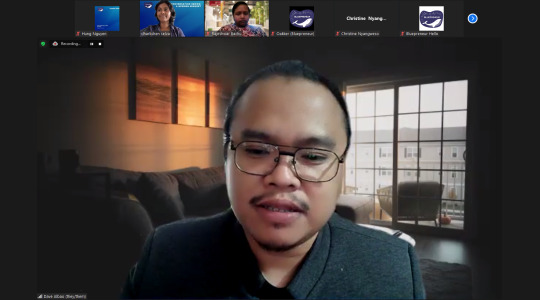
0 notes
Photo

Reposted from @kevin.m42 | @uwiydp For the second time, I have the honour of hosting a session on Climate Change. This one is just as significant as the first which was done in New York City. This virtual Global Youth Network Summit on Climate change and Health will take place on July 10th, 2020. I'll be hosting a power panel entitled ‘Covid-19 and the Environment, What’s Next?’ with youth from across the Caribbean and North America. This panel is exceptionally important as they discuss the increasing challenges to youth and how best can we ensure that the environment remains a top priority even in a Covid-19 prevalent society. Join us on Friday 10th July, 2020 at 9 AM EST - 1 PM to hear this panel and many more interesting speakers! More Information and registration is available at: http://bit.ly/2BrzvA6 Check out a bit more about me via the brief bio below. Kevin is currently a Project Officer with The University of the West Indies Youth Development Programme. Located in Barbados, his work with The UWI YDP covers 18 countries and territories across the Caribbean region. He is a national of Barbados but maintains a global focus to understand the challenges that could present itself to the Caribbean region and its youth. He maintains a focus on the field of Development, notably areas of climate change, sustainable finance, health, human rights and security. Through his work with The UWI Youth Development Programme, he has coordinated and partnered with local, regional and international organizations on programmes and initiatives as well as advocated for a stronger voice and representation for the youth of the Caribbean region. #climate #climateaction #covid19 #environment #advocacy #biodiversity #caribbean #uwi #motivationalspeaker #motivation #determination #future #youthvoice #youth #youthsummit #youthadvocates (at ScholarshipJamaica.com) https://www.instagram.com/p/CCazhbLhOpZ/?igshid=vf8bwpd7rshd
#climate#climateaction#covid19#environment#advocacy#biodiversity#caribbean#uwi#motivationalspeaker#motivation#determination#future#youthvoice#youth#youthsummit#youthadvocates
1 note
·
View note
Text
Human Nature Projects International
In conversation with Elliot Connor, CEO and Founder, Human Nature Projects International
How old are you?
I’m 16 years old- that funny age in which you’re no longer completely blocked out by duty of care bureaucracy, but still not quite an adult. Anyway, it helps to make me stand out a little from the crowd, and there’s plenty of youth-related opportunities out there if you know how to look for them.
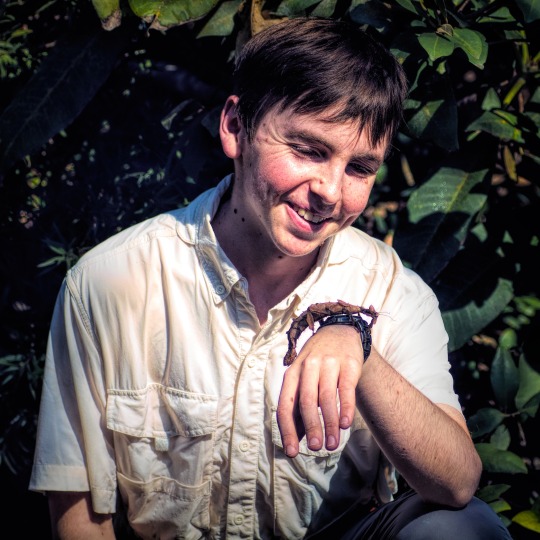
When did you first start getting involved with conservation and the environment?
With these things, it’s very hard to pinpoint an exact time and place. My family being British, we’d always done some very amateur birdwatching and taken the occasional trip overseas to watch wildlife. But it was probably just before my sixteenth birthday when things really kicked into place: I took up a volunteering position with Birdlife Australia at a discovery centre they ran in a local park, working with lots of very old retired folks to chat to families and other visitors. It was admittedly a little dull, but it allowed me to start amassing contacts in the environmental sector, and the opportunities sort of sprang from there.
What does Human Nature Projects do?
Human Nature Projects is connecting people for the planet because together we can make a world of difference. We are reimagining conservation, creating a community vision for mutual respect and prosperity amongst all our Earth’s many lifeforms. We come from all walks of life, from every continent, speaking many different languages- yet we are joined by Earth’s universal tongue: the appreciation of mother nature, and an undying passion to protect it.
At last count, we have about 500 members coming from 70 countries across the globe, bringing to this movement their skills and experience in all manner of fields, their passion and connections, their vision for a future world. Together we work to promote a model of simple, holistic environmental volunteering whilst raising awareness of the conservation issues at hand and equipping the young generation with the skills to solve them.
Many people say that it is ‘human nature’ to destroy our planet out of greed, exploit other lifeforms to the point of extinction, and forget of their plight in our own short-sightedness. We say otherwise. Human Nature should be a force for good- a story of connection, collaboration and community which ends in a prosperous future for creatures great and small.
It is this very same philosophy which Human Nature Projects brings to all of its activities, our powerful network of nature-lovers growing organically through experiential learning and community leadership. Our mission is to restore humanity’s appreciation of Earth’s amazing biodiversity, reminding people that we needn’t be (indeed are not) the superior species on this planet.

Aren’t there enough environmental groups already? What is it that makes you so special?
First off, we’re an open group- everyone (and I mean everyone) can get involved, and play a useful role in helping grow the collective. Because it shouldn’t be hard to help our planet, and people need to feel they can change things, that they are important. I guess you could call HN more of a movement, and we certainly hope our numbers will reflect this in future.
Second, we’re a huge believer in collaboration- working alongside many organizational partners and existing networks to show our support far more than would be expected for a charity of our size. It really can’t be overstated the need to communicate and collaborate effectively with other NFPs in the field to grow audience and funding for mutual benefit and ensure efforts are not duplicated.
Last but not least there’s our philosophy. Trying to change the way people view animals is a task that most organizations shy away from, but it’s also the most important thing anyone can do. It takes a lot of thankless work with little or no funding, but in the end, it surely will be worth it.
How can one get involved in HNP?
First off, we’d get you to complete our volunteer sign-up on Google Forms. It’s quick and easy to fill out and will allow us to link you up to the national director in your country who will get in touch for a quick chat. After that, we’ll use the information you’ve provided to link you up with one or more of the volunteer working groups we have running, headed by members of the HNP executive committee. And that, as they say, is that.
So what’s in store for the future? Any big plans?
There’s plenty to look forward to. October will see the launch of our Conservation Connection network- HNP’s attempt to walk the talk and promote some solid inter-organizational discussion. Then in the new year, we’ll be launching the Credit2Nature day, a global awareness campaign to make people think about all nature has done for us and how little we have given in return. Working with 1% for the Planet among others, we hope to make this event an opportunity to raise fundraising levels for conservation as a whole, and in doing so establish a precedent which will help tremendously for the future.
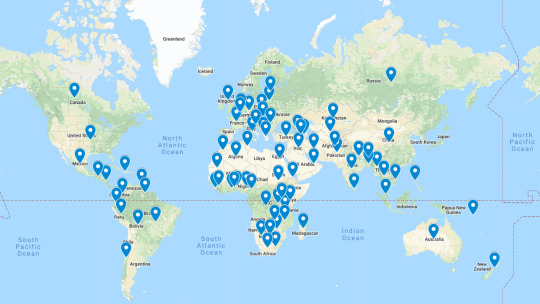
How did you first find out about the topic you are passionate about/your work focus?
Well, the long answer is that I spent two hard years trying to break my way into the environmental field: giving heart, body and soul to volunteering for more organizations and projects than I could count, sending hundreds of emails to offer my help, and generally making a fool of myself. Yet after all that, I had met zero young people, made zero useful connections… and, well maybe I had a few memorable experiences. No-one could understand my work, let alone why I did it. So I came to a decision that this wasn’t good enough, that we needed to do more to support the likes of myself- those keen young students and youths wishing to make their mark in the world. And that was how Human Nature Projects began.
What is one thing you’d like older generations to know?
I don’t think there’s anything that they don’t know already… it’s more about reminding them of certain things. Firstly, young people do care for our planet, and above all you must not give up on them. Secondly, that we need support: mentoring, community, resources, and most of all belief that our crazy ideas, our ambition has the power to change the world. And last of all, that we forgive them for what they have done to the Earth because they were unaware at the time. All that matters now is that they help to fix it.
Do you think youth should have more of a voice in environmental discussions?
Yes, absolutely. Environmental management is a very unusual field in that it cannot claim to have existed for more than the past fifty years but still lives in a sort of no-man’s land between the world then and the interconnected, rapidly evolving world of the present day. The wizened leaders of the movement continue to hold excessive power, handicapping the success of the whole by making it inaccessible, exclusive, bureaucratic, conservative and isolated from the general populace. We need a sort of people’s planet, everyone’s environment philosophy if the movement is going to grow, and it is the sort of ambitious thinking provided by youth which ultimately will bring this about.

It must be tough starting something so epic and large-scale as a minor. How do you make people believe in what you say?
You tell me! Sure I’ve experienced my fair share of setbacks and straight-off no’s, but taking a step back to look at the bigger picture it’s mind-blowing how supportive people can be. It takes only a little courage, some unbounded optimism, and a liberal dose of enthusiasm to begin turning heads. Then, of course, once things pick up it’s you and your army with enough manpower and voices to start a nice little avalanche.
Okay- how about a favourite quote? Or two, if you prefer.
“I think sometimes we need to take a step back and just remember we have no greater right to be here than any other animal.”
David Attenborough
#youthforourplanet#climate change#climate crisis#hnp#asiapacific#savetheplanet#saveourplanet#wildlifeconservation
5 notes
·
View notes
Text
"From Thursday 25 to Sunday 28 July, Extinction Rebellion will be spreading the message of Internationalist Solidarity in addressing the Climate and Ecological Emergency at WOMAD, the UK’s biggest festival devoted to music, arts and dance from around the world.
As well as hosting speakers and performers from around the world on their Rebel Rebel Stage throughout the festival, Extinction Rebellion will be holding a Celebration of Life on the Charlie Gillett Stage on Saturday morning, culminating in a Rebel Roar in defence of the planet; ceremonially reading an advanced copy of the Global Witness list of murdered indigenous activists in 2018; and recreating the Garden Bridge from the April Rebellion in London, with saplings from the trees which survived the Battle of Verdun.
From 10am on Saturday, Skeena Rathor of Extinction Rebellion’s Visioning team will lead a Celebration of Life on WOMAD’s Main Stage. This will honour the courage and successes of Earth Protectors around the world, rejoice in a shared faith in humanity and nature, and call for the restoration, regeneration and rewilding of the one planet we all call home. Youth speakers from around the world will be joined by festival musicians and the Invisible Circus in telling the story of Extinction Rebellion. There will be a guided meditation, stories from children, a Gaelic hymn of mourning honouring Global South activists killed on the front line and music in support of Extinction Rebellion from Undercover Hippy. It will culminate with a call to action and children leading the audience in adding their voices to the Rebel Roar, a powerful expression of fierce defiance in defence of the planet, accompanied by a waving sea of Extinction Rebellion flags.
The Celebration will also include a solemn ceremony led by Kofi Mawuli Klu, who will read out a list of indigenous activists murdered around the world in 2018. This list is an excerpt from an advance copy of the annual Global Witness defenders report, due to be released publicly on 30 July. Indigenous activists protect over 70% of the Earth’s biodiversity. The ceremony will honour those murdered for defending their lands and this biodiversity from western mining interests and the fossil fuel industry.
Extinction Rebellion will also be recreating the atmosphere of the Garden Bridge at WOMAD with trees decorating the Rebel Rebel tent, as they did Waterloo Bridge during the International Rebellion in April. These will afterwards be given to good homes in underprivileged neighbourhoods, just as the trees from Waterloo Bridge were.[1] In this way, WOMAD will be transformed into Waterloo Bridge, just as Glastonbury was Oxford Circus, with the iconic pink boat. Following this, Wilderness will become Parliament Square and Boomtown Marble Arch, retelling the story of the Spring Rebellion across the Summer’s festivals, while recruiting for the Autumn Rebellion.
Among the trees being brought to WOMAD are two Verdun saplings, a horse chestnut and an oak, direct descendants of the last remaining trees from the single deadliest battle in human history. The Battle of Verdun in World War One left a million dead and injured in one single military engagement. The few Verdun Trees left alive after this battle of unimaginable horror became a symbol of peace, so the Verdun saplings at WOMAD will represent loss, sorrow, peace and regrowth.
On top of all this, Extinction Rebellion will be hosting a full programme of talks, performances and workshops at the Rebel Rebel stage and tent throughout the festival. Indigenous elders from around the world will highlight the importance of internationalist solidarity in the struggle for climate justice. There will be performances from musicians from around the world, talks on the Climate and Ecological Emergency and what to do about it, nonviolent direct action training, and various other workshops.
Skeena Rathor of Extinction Rebellion’s Visioning team says: “Solving the Climate and Ecological Crisis is the greatest and most complex challenge that we have ever faced, and we need to work together in order to do so. The ethos of WOMAD and Extinction Rebellion is a natural fit, so I think we’ve found our festival home. We communicate through stories, so we are so delighted to have a stage at WOMAD and a platform to tell our story. Life is a precious and beautiful miracle. We must take joy in our existence, so we will be holding this Celebration of Life and calling on all there to Rebel for Life, to Dance and Disobey and join the movement of our lives. We will not stop until we win.”
Coordinator of Extinction Rebellion’s Internationalist Solidarity Network Kofi Mawuli Klu says: “The fight for Climate and Ecological Justice around the world is ongoing. There are 27 million indentured slaves in the world right now. Young children are forced to mine for heavy metals. Resources are being plundered by rapacious Western corporations and courageous individuals are dying on the front line trying to stop them. Climate disasters strike with increasing and frightening frequency, with the Global South hit the hardest.
“But there are also many signs of hope, with indigenous people winning victories in legal battles, conservation efforts and tree planting around the world and increasing solidarity between activists in the Global North and South. What we choose to do now does make a difference and a different way of ordering the world is within our grasp. We have one planet so let us share it together equitably and wisely. Join Extinction Rebellion and Rebel for Life”
WOMAD’s Global Festival Director Chris Smith said: “WOMAD exists because of the ability of people of different cultures to collaborate positively and creatively, and so we’ve been inspired by the efforts of Extinction Rebellion to create such huge energy and global solidarity around the urgent need to tackle the ongoing climate and ecological emergency.
“It’s exciting that our two organisations will be able to come together this weekend to both celebrate the global cultures that form the core of our humanity, and inspire people to act to help preserve our species, our planet, and with them the global music art and culture we’re celebrating this weekend.” "
#extinction rebellion#climate crisis#climate action#climate activism#climate change#climate emergency#extinctionrebellion#extinction
9 notes
·
View notes
Text
ENVR 2000
BLOG Resources (40%)
Part 1. Read ( /5)
Read the document listed below and answer the question in your Blog.
Truth and Reconciliation and Sustainability
Read the Introduction (pp. 1-23) of the document Honouring the Truth, Reconciling for the Future - Summary of the Final Report of the Truth and Reconciliation Commission of Canada.
http://nctr.ca/assets/reports/Final%20Reports/Executive_Summary_English_Web.pdf
If the link does not work, simply go to www.trc.ca and find the report listed above.
Part 1. Question
How does Truth and Reconciliation in Canada relate to the UN’s Sustainable Development Goals?
https://sustainabledevelopment.un.org/?menu=1300
Ans.
The sustainable Development Goals are the blueprint to achieve a better and more sustainable future for all. They address the global challenges we face, including those related to poverty, inequality, climate change, environmental degradation, peace and justice.
Truth and Reconciliation in Canada relates to the UN’s Sustainable Development Goals in some aspects such as No poverty, Good Health and Well being, Quality education, Gender Equality, Reduced Inequalities AND Peace, Justice And Strong Institutions.
1.In the book Honouring the Truth, Reconciling for the Future they said that Canada separated children from their parents, sending them to residential schools and it was done not to educate them, but primarily to break their link to their culture and identity and after they started healing. President of the Métis National Council Clement Chartier spoke to the Commission about the importance of truth to justice and reconciliation. At the Saskatchewan National Event, he said, we are, however, the products ... of the same assimilationist policy that the federal government foisted upon the Treaty Indian kids. So there ought to be some solution.... The Métis boarding schools, residential schools, are excluded. This is same as UN’S sustainable goal known as Quality education.
2. Reconciliation must inspire Aboriginal and non-Aboriginal peoples to transform Canadian society so that our children and grandchildren can live together in dignity, peace, and prosperity on these lands we now share. This represents the Peace, Justice and Strong Institution goal of Un’s sustainable goal.
3. At the Alberta National Event in Edmonton in March 2014, an Indigenous youth spoke on behalf of a national Indigenous and non-Indigenous collaboration known as the “4Rs Youth Movement.” Jessica Bolduc said, We have re-examined our thoughts and beliefs around colonialism, and have made a commitment to unpack our own baggage, and to enter into a new relationship with each other, using this momentum, to move our country forward, in light of the 150th anniversary of the Confederation of Canada in 2017. Our hope is that, one day, we will live together, as recognized nations, within a country we can all be proud of. This explains the Reduced Inequalities sustainable concept of UN’s sustainable development goal in Canada’s Truth and Reconciliation process.
4. Canadian government owned the land of aboriginal people and they negotiated and occupied aboriginal people land. and after they stop doing this destruction to aboriginal people with reduces poverty for native people and this is same as UN’s No Poverty development.
5. Canadian government disempowered the aboriginal women who have powerful role in their nation. There were some cases of sexual abuses to the women but after at a Community Hearing in Tunder Bay, Ontario, Merle Nisley, who worked at the Poplar Hill residential school in the early 1970′s, said, Where wrongs were done, where abuses happened, where punishment was over the top, and wherever sexual abuse happened, somehow we need to courageously sit and talk about that, and apologize. I don’t know how that will happen. This represents the Gender equality goal of UN’s sustainable development.
Further, the government of Canada apologizes for all the things they done to aboriginal people and repairs all the destruction and made Quality Education, Gender Equality, Reduced Inequalities, No Poverty And Peace, Justice and strong Institution workable in Canada.

Reference: http://nctr.ca/assets/reports/Final%20Reports/Executive_Summary_English_Web.pdf
https://sustainabledevelopment.un.org/?menu=1300
Part 2. Watch ( /2)
Watch each of the following and answer the questions below.
How tress talk to each other – Ted Talk, Suzanne Simard
https://www.ted.com/talks/suzanne_simard_how_trees_talk_to_each_other
Why I love vultures – Ted Talk, Munir Virani
https://www.ted.com/talks/munir_virani_why_i_love_vultures#t-46531
Part 2. Question
How did the information presented in the talks above affect how you think about nature?
Ans. Before I listed the talk, I had a different prospect for a nature but after watching the talks my views got change about nature. I come to know that how trees in the forest communicate with each other not only from below the grounds but from above of the grounds also. Forest is a place for trees with lots of connected herbs, network, nod and this is how they talk with each other. They not only share carbon but they also share and communicate with nitrogen, phosphorous, water, signals and hormones and scientists called this underground symbiosis.
2.What aspects of nature and biodiversity do you feel are most important to protect? How can you take action to protect this aspect?
Ans. Protect the Forests because it provide shelter to many animals as well as provide food, medicine which are main resources of human. Plants are important for ecosystem because they exchange gases with atmospheric air and also they are important for sustainable development of environment. Vultures are important aspects of nature and biodiversity. They help us and our nature in various ways and they are needed to be protected. They are natural degraders of dead animals and they prevent the spreading of diseases to humans and animals. They maintain a healthy ecosystem so, we should become active and make noise about these creatures and appreciate the services that they provide to us and our nature. These issues will not solve locally so government should educate people by advertising about the benefits of having vultures in nature. Moreover, people can volunteer their time to spread the word and inform about this issue to everyone.
Part 3. Action ( /2)
Spend 1 hour in silence in nature and reflect on the following questions.
Part 3. Question
Describe where and when you spent your time in nature.
Ans. I felt the need to sit alone for clear thoughts and positivity. So, I went to my “peace spot”. Every-time I feel low or exhausted, I go to my usual spot for positive vibes and energy. There are steps (besides the river) which go down inside the water. This spot is on the side at the Folks. I went there in the evening and I like to sit on steps pouring my feet under the water and last I Visited there on November 8, 2019.
https://bahbs.files.wordpress.com/2010/11/dsc00305.jpg

2. What did you experience in your time in nature? What did you see, hear, smell, and feel? What effect did this time in nature have on you?
Ans. It was late evening, city lights everywhere. The view from the spot is mesmerizing. Feeling water under feet and smelling fresh air, this experience is very peaceful. I do hear the sound of water waves, air rushing through trees, calming my soul. It is a kind of therapy to me which helps me to think distinctly for every second thought I had.
Part 4. In-class Blog Questions A ( /3)
Human Environment Connections
1a. what promotes human connection to nature?
Ans. Human depends to a large extent on nature. Human uses all the resources obtained from nature like wood, air, water, food and many other things. Somehow, these resources also promote human connection to nature. Moreover, going to parks, gardens or forests can promote human connection with nature. One should go to parks away from disturbance and can observe the trees, birds and can also feel air that help them to feel free of stress. People can do camping, boating and other activities that will help them to connect with nature. There are many cycles like carbon cycle, phosphorous cycle, hydrological cycle, sulfur cycle and nitrogen cycle that is biologically done by nature and benefits human beings and other things on earth.
https://tse3.mm.bing.net/th?id=OIP.rYT1A7VbhTWiROT1nmtblAAAAA&pid=Api&P=0&w=300&h=300

1b. what promotes disconnection from nature?
Ans. There are many things that promote disconnection with nature. First of all, living in urban area where there is a huge traffic, noise, and pollution makes disconnection of human from nature. People living in cities are not able to get fresh air and due to traffic there is noise that disconnect human from nature. Secondly, people disrupt biological cycles by producing green house effect to environment; they produce more carbon dioxide, nitrogen dioxide, sulfur dioxide and other gases by burning fossil fuels that affect natural beauty of earth.
1c. Is there a danger to a growing disconnect from nature?
Ans. obviously, there is a huge danger to a growing disconnect from nature. By disconnecting from nature, stress level of people are rising, they are getting more vulnerable to diseases. Due to their busy life in modern era people are neglecting the values of nature and they are putting themselves and their future generations in danger. People cut trees, burn fossil fuels that effect environment that disrupt the biological cycles and by doing this there future generations will not get all the resources as they used.
Worldviews
2. Where do your environmental ethics lie?
Ans. I believe in Deep ecology because it says that all the things are equally important rather they are living or non-living. It says that human cannot destroy or change nature because of their personal needs. Interfering with the nature means interfering with the sustainability of an environment. For example cutting trees and making roads through rocks is interference with nature for personal needs and benefits of human.
Wildspaces
3a. Can parks meet its dual mandate of access and protection?
Ans. I think parks can meet its dual mandate of access and protection only if people were restricted within a limit of disturbing the nature and animal species in parks. People should not disturb the natural environment of parks. Government can restrict some area for humans to enter where there is endangered species so that they cannot affect that species. Government should restrict people from entering people to some areas so that they cannot disturb the habitats of someone others home by this I mean animals home. People can watch animals from far away without affecting there environment and by doing this park will meet its dual mandate of access and protection.
3b. How can this be achieved in Wapusk?
Ans. In Wapusk national park number of visitors are limited which help park to become disturbance less. Less people visiting parks means less pollution of vehicles and fewer disturbances to animals in park which is good for animals. Moreover, restricted some areas in Wapusk help animals to be more protected from human activities which make this protection act more safer.
Part 5. Listen ( /2)
Slow Movement
Listen to one of the podcasts on implementing “slow” in the modern world.
http://www.carlhonore.com/unlock-slow/podcasts/
Part 5. Questions
Describe 3 challenges and 3 opportunities that you see in the slow movement. Do you want to slow some aspect(s) of your life? If so, what concrete steps can you take to achieve this?
Ans. I listened to Welcome to New Slow City. In this Carl speaks to William Powers about New Slow City, the book he wrote about living Slow in New York. I listed this because I was having many thought after reading the name New Slow City. Big cities are fast cities and it was amazing to listen to thought of William Powers that tell us that how to become slow in such a big city.
There are many challenges living slow in a New York City. First main challenge in living slow in such a big city is that there is workaholic environment. This means that everyone living there is having busy life schedule which means they work fast and always remain in hurry. New Yorkers have one third the carbon footprint the average Americans. So, there is being carbon intensity to being in a city and there is a lot of more logical transport. Second challenge that comes in a way of living slow in a big city is that the living area is very small which means that mostly people live in tiny apartments where it is not easy to adjust. Furthermore, there are long buildings which mean birds do not sit on the roofs as they sit in village rooftops. The hardest challenge is the culture in the city. William Power said that you cannot change culture but the culture changes you. It is very difficult to adjust in such a big city where everyone rushing around.
The opportunities in the slow movement in the New York City are going to places which are noise and pollution free. The west village in New York is good opportunity to get slow in such a big city because their you cannot listen highway noise anymore and the Rambo in essential park and the Chinese Decort of art where nobody goes is good to approach slow revolution movement. So, it is recommended to spend 10 minutes daily there. People went there and assume that they were slow now in nature. The other opportunity to become slow is working efficiently and patiencely. People do not have to work too much they have to take rest as well and also they can go to some places which is close to nature. The other opportunity is the gadgets that save the time of the human. The labor has become 3 times more efficient since 1970’s in US. Connecting with other people feels good and good approach to slow down in fast world. Reserve some of your mental space for non-market place for you and this is too beautiful
I would like to slow myself in this modern era because rushing our self give stress to mind and body. Slowing down will help me to know about every little detail about things. I will go to garden or park and sit there which will help me to relax my mind. Anticipation, going to restaurant a while in a week, talk with my friends and have good food will help me to achieve slow revolution.
Part 6. Action ( /11) Complete each part.
Investigate the chemicals in 5 of your household’s personal care products. Use the product guide from the Environmental Working Group http://www.ewg.org/skindeep/ to see how your products are rated for carcinogens, endocrine disruptors, etc. ( /3)
Ans. a. Dove Sensitive Skin Hypo allergic Beauty Bar, Fragrance Free
HIGH
· Multiple, additive exposure sources
· Irritation (skin, eyes, or lungs)
· Occupational hazards
· Use restrictions
MODERATE
· Contamination concerns
· Organ system toxicity (non-reproductive)
LOW
· Enhanced skin absorption
· Ecotoxicology
b. Colgate Total Sf Whitening Toothpaste
HIGH
· Multiple, additive exposure sources
· Contamination concerns
· Irritation (skin, eyes, or lungs)
· Miscellaneous
· Persistence and bioaccumulation
· Use restrictions
MODERATE
· Organ system toxicity (non-reproductive)
LOW
· Enhanced skin absorption
· Ecotoxicology
· Occupational hazards
c.just the goods vegan bath salts, unscented
LOW
· Enhanced skin absorption
d. CVS Health Dandruff 2 in 1 Shampoo & Conditioner
HIGH
· Multiple, additive exposure sources
· Contamination concerns
· Irritation (skin, eyes, or lungs)
· Miscellaneous
· Persistence and bioaccumulation
· Use restrictions
MODERATE
· Organ system toxicity (non-reproductive)
LOW
· Enhanced skin absorption
· Ecotoxicology
· Neurotoxicity
e. Nivea Anti-Perspirant Dry Comfort Roll-on
HIGH
· Contamination concerns
· Miscellaneous
· Use restrictions
MODERATE
· Irritation (skin, eyes, or lungs)
· Organ system toxicity (non-reproductive)
LOW
· Enhanced skin absorption
· Ecotoxicology
2. Do an analysis of your purchases for one week. Record all products, food, beverages and services purchased over this period. Create screening criteria to categorize all items as “Good”, “Bad” or “Ugly”. The criteria is up to you, but must be justified. You may wish to consider factors such as: environmental impact, social impact, local or foreign, corporate or small business. Add up the dollar values spent in each category and reflect on where you would like to make changes – if any. ( /3)
Ans.
a. 2 Bottles of Coke
Price= $2.26
Criteria= Bad
Drinking coke is not good for health because it can damage the lungs of human and can also contribute in Type 2 Diabetes. It is available in plastic bottles that are environmental hazard.
b. OM White Bread
Price= $1.57
Criteria= Bad
It is bad for health because they are processed foods and can do obesity and heart diseases. The cover of Bread is made up of plastic which is bad for environment too.
c. Cranberry Juice
Price= $4.88
Criteria= Good
Drinking cranberry juice is good for health because it contains a lot of vitamin C which is antioxidant and it also improves immune system.
d. Clorox Wipes
Price= $3.94
Criteria= Good
It is good to environment and health because it removes germs from surface and kills many type of bacteria and viruses which are threat to environment.
e. Biscuits
Price= $8.98
Criteria= Bad
They are bad for health and environment because eating biscuit can increase your blood sugar level and do obesity. The packet of biscuit is made up of plastic which is bad too.
f. Basmati Rice
Price= $9.97
Criteria= Good and bad
Basmati rice is good for person who needs carbohydrates and bad for person who is fat. They contain amino acids which is good for health.
g. Milk
Price= $5.17
Criteria= Good
Milk is the great source of calcium and it also contain many other essential nutrients that are good and the bottle of milk can be recyclable.
h. Large eggs
Price= $12.32
Criteria= Good and Bad
Eggs are good source of protein but they are good for people who need protein and who exercise,. But on the other side it also increases cholesterol level in human which affect the health and increases blood pressure. The packing of eggs is in hard paper which can be easily recyclable.
i. Bananas
Price= $2.97
Criteria= Good
Eating banana is good for health because it contains vitamin C, Manganese and potassium. It is recyclable.
My analyses show that the items that I bought, some were bad and some were good for human and environmental conditions. I would like to make changes in my purchases such as buying more good products as compared to bad products. I will take care of environment too.
3. Investigate the options and end fate of your household’s e-waste. Discuss where and how you will dispose of this waste and your future electronics purchase plans in relation to the waste they will one day become. ( /2)
Ans. The e-waste produced by my household is not too much because I do not buy much electronics because it may harm my health in long term. Like, working on computer for long time may affect my eye sight and using microwave can cause cancer. So, I barely use these items but I recycle the e-waste in electronics recycler that I produce. In future I will purchase items from the store that will give me trade back option so that after using the electronics I can sell the waste to the shop again and it will not produce any environment pollution. Recycling the e-waste is the good way because by doing this the valuable things are extracted from the waste and the other one may be reused after proper treatment.
4. Consider your food system and the ways in which you can improve the sustainability the food that you consume and throw away. Are there ways to improve sustainability such as shopping locally, growing your own food or reducing your household’s food waste? Which options might suit your household and value system? Create a plan for one change that you think would improve the sustainability of your food system. ( /3)
Ans. I mainly buy organic food from superstore or sometimes directly from farmers who produce it. But I think that growing my own food in garden is the best way to improve sustainability of food. By doing this I can reduce the cost of purchasing food from superstores. The food waste produced can be used as a fertilizer in garden and the food will be organic without chemical fertilizers. Moreover, I can produce food according to my consumption that how much I need and this will automatically reduce food waste and there will be no overproduction and spoilage of food.
Part 7. In-class Blog Questions B ( /3)
Zoos
a. What role, if any, should zoos play in conservation / education?
Ans. Zoos play an important role in conservation and education. Zoo is an establishment which maintains a collection of wild animals, in parks or gardens. Zoos are good for conservation of animals that are going to be extinct soon. Zoos are good to do the study and preserving endangered species. Zoos provide people with many types of animals inside captivity that someone cannot see in the forest. Zoos provide the great value to study animals and also people got much knowledge about animals and their behaviour.
b. Is it ethical to keep animals in zoos? If so, what size / type of animal or zoo?
Ans. It is ethical to keep animals in zoos but only if zoo should provide them proper environment, nourishment and care. All types of animals can be kept inside zoo but also zoo is a great place to preserve endangered species. Zoos should provide same environment to animals as their natural habitat and the size of animals depend on the space that zoo provide to them for their good growth.
c. Do you enjoy visiting zoos?
Ans. Yeah, I like visiting zoos because it contains many species of animals that were first unknown to me. I got knowledge about many animals like lion, bears and many others. It makes the relation stronger between my family members. Moreover, it provides me the knowledge about the nature of animals as such as their value to environment.
https://media-cdn.tripadvisor.com/media/photo-s/08/42/f1/36/assiniboine-park-zoo.jpg

Food
Consider your food system:
a. What do you like about it?
Ans. I like my food system because it provides people with proper nutrition and good health, with all types of foods that is required by one to maintain proper health and body. It includes all processes such as growing, harvesting, processing, packaging, transportation, marketing and consumption. The food is properly packed with all the information given about the ingredients that it contains inside it. The food packed is fresh and good to consume before the expiry date given. Moreover, the food in the market is of all varieties that share the equality between people.
b. What do you dislike about it?
Ans. The thing that I dislike about my food system is the cost of the products. The cost of the foods is much higher than their nutritional value. The cost of organic food is too high that only some person can afford it. Moreover, there is spoilage of food when food is overproduced. An antibiotics used on foods can cause water and air pollution which is an environmental issue.
Oceans
1. What are your primary concerns about the oceans?
Ans. Oceans are habitat of many plants and animals. Main concerns about oceans are throwing plastic substances in water which are affecting the marine life. However, plastic disrupts the habitats of marine animals. Other concerns about ocean is pollution that causes green house effect and acidification of ocean and coral bleaching. Studies have shown that in 2050 there will be more plastic than fishes in the sea. Many fishes for example whales eat plastic bags which cause them to die. Marine animals consume plastic things and eventually die and this also effect the natural cycle of marine life.
https://i.pinimg.com/originals/a8/e8/1e/a8e81eac468689173c165118fb55fc3c.png

2. What, if anything, do you plan to do about it?
Ans. People should avoid using plastic bags. People can use other materials instead of plastics that are biodegradable and eco friendly. Moreover, government should give education to people about the bad effects of using plastic and government should provide dustbins in public places for people to dump garbage instead of throwing it outside in environment. There should be proper treatment of water so that toxins cannot be produced in water that kill marine animals as well as humans.
https://st3.depositphotos.com/7901612/15355/v/1600/depositphotos_153556000-stock-illustration-stop-ocean-plastic-pollution-vector.jpg

Part 8. Sustainable Wellbeing ( /12)
a. Happiness, Wellbeing and Sustainability

b. Connect with Ourselves, Connect with Nature
Ans. When I am outdoors, I usually like sunny days. I remember once I did my assignment while sitting outside the campus of my University. I was sitting on the grass with my friends and it was a sunny day with cool breeze crossing us. I really enjoyed that moment sitting close to nature and the surroundings were much peaceful which made my concentration even better. I often do running in morning in the park near my house which help me to feel relax. This also helps me to maintain my body fitness and the fresh air relax my mind. People with their pets also come to do jogging in park and I like to play with their pets that sharp my mind. Eating my favorite food while sitting in nature seems to be heaven for me. It feels like I got everything on world that I want to have. So, connecting our self with nature enhance our mind work, relaxes our mind and helps to enhance concentration and also makes us healthy.
After undertaking this activity with mindfulness, write a paragraph or two on your gratitude for what you have just experienced. Consider how the activity felt, how it added to your experience of your body, the world and living, with more presence and connection. ( /3)
c. Solution Revolution
Ans.
Indoor exercise: I like to workout at my home as well as at gym. I have every-basic equipment required so that I can exercise indoor which is more efficient. Even if it’s the bad weather outside, I can still workout inside my house. Moreover, I usually go to gym on weekend with my friends, mainly 6am in the morning. I started gym approximately a year ago and it helps me to maintain my body fitness. Further, I really take care of my diet which I make sure is a balanced meal. By doing all these activities it sharps my mind and make me stress free which can enhance my wealth in future.

Spending time in Library: I really like to spent time at library reading fictional, mysterious kind of books in my free time. Usually I went to library on weekend in evening time. The environment in the library is calm which help me to concentrate more. It enhances my knowledge and while closing my eyes it feels very pleasant and looks like sitting free of thoughts and stress. It provides me positivity in my life and increases my patience level. Studying in library will improve my communication skills which can help me achieving my future goal. It will also help me to increase my reading skills which will help me in my future study and job.

3. Cooking;Cooking is my hobby and I got knowledge about cooking from my mother. I started cooking since I was in 6th grade. Now I cook daily in the morning around 7am and in evening in between 7pm to 10pm. Once I participated in a cooking competition and won first prize and then I got confidence that I can pursue cooking as my career.

1 note
·
View note